- 123种Java设计模式
- 22024中国AIGC广告营销产业全景报告
- 3软考高项-信息网络安全模拟题_公钥基础设施(pki)也称公开密钥基础设施。以下不属于pki的组成的是()
- 4micromamba快速安装(windows版本)_windows mamba
- 5上海市计算机学会竞赛平台2021年5月月赛丙组数球数_上海计算机学会竞赛平台五月竞赛题解
- 6抖音seo源码,抖音seo优化系统技术一手源头搭建开发_抖音权重查询网站源码
- 746.整理华子面经+笔试+排序算法_华子面试
- 8【C语言数据结构】双向循环链表_c语言双向循环链表
- 9Wireshark抓包——TCP协议分析_wireshark tcp
- 10十二个常见的Web安全漏洞总结及防范措施_web应用常见漏洞
Linux 进程间通信 管道系列: 匿名和命名管道,自定义shell当中命令行管道的模拟实现_shell和进程通信
赞
踩
Linux 进程间通信1: 匿名和命名管道以及进程池的实现
一.进程间通信的介绍
1.为什么要进程进程间通信?
因为有些情况下需要进程完成以下任务:

而我们知道进程之间是不能进行"数据"的直接传递的,因为进程具有独立性
因此才有了我们今天要谈论的进程间通信
2.什么是进程间通信
通俗点讲,进程间通信就是一个进程能够把自己的数据交给另一个进程
进程间进程通信就是进行数据的交互,那么数据存放在哪里呢?
下面我们来分析一下
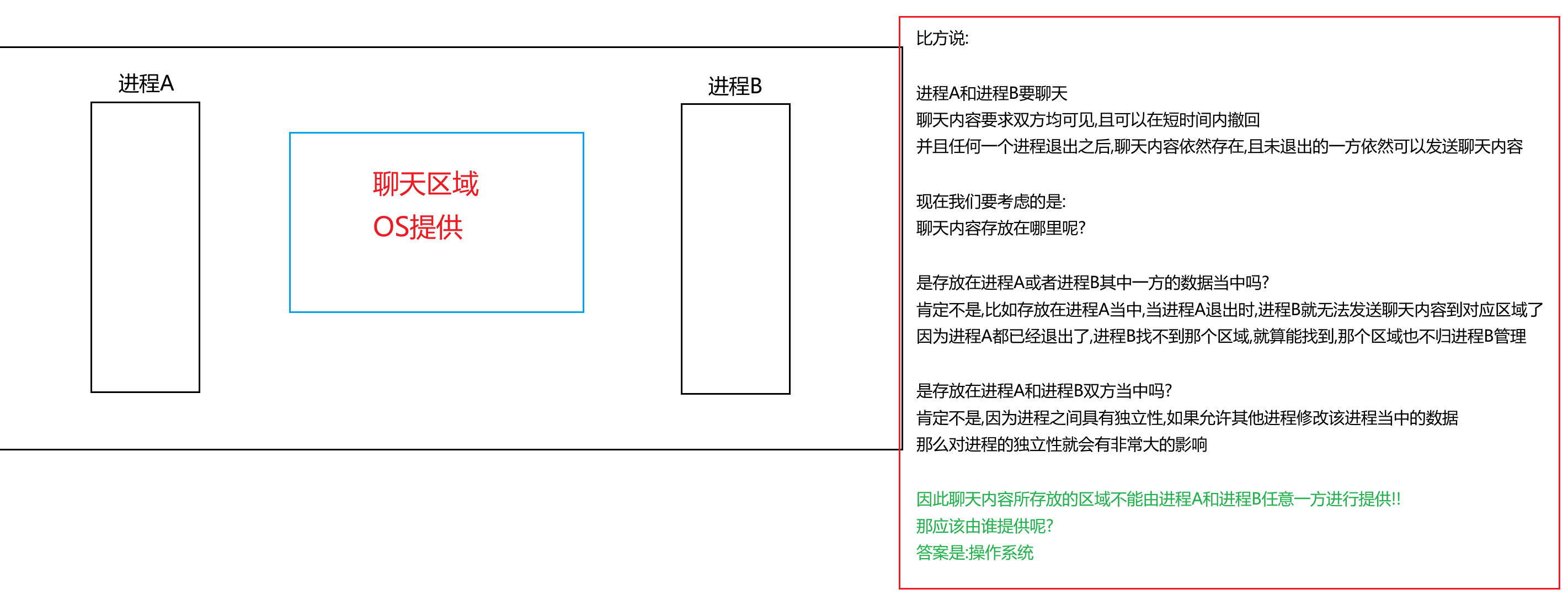
因此,关于进程间通信的一个非非非非非非常重要的结论就得出了:
进程间通信的本质是让不同的进程,看到同一份资源(一般都是要由OS提供)
3.进程间通信的具体做法
因为OS提供的"数据存放的空间"有着你不同的样式,就决定了进程间通信有着不同的通信方式
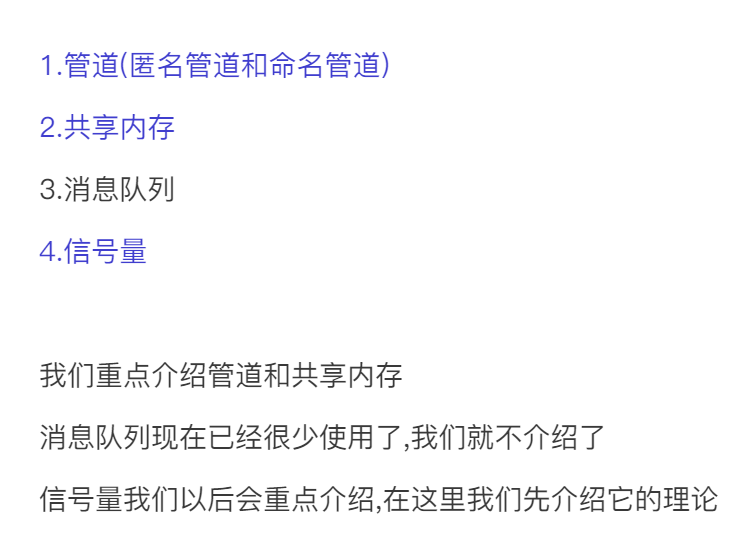
二.管道
管道的本质就是一个内存级文件,不存储在磁盘上,只存储在内存当中
1.从文件的角度理解什么是管道?
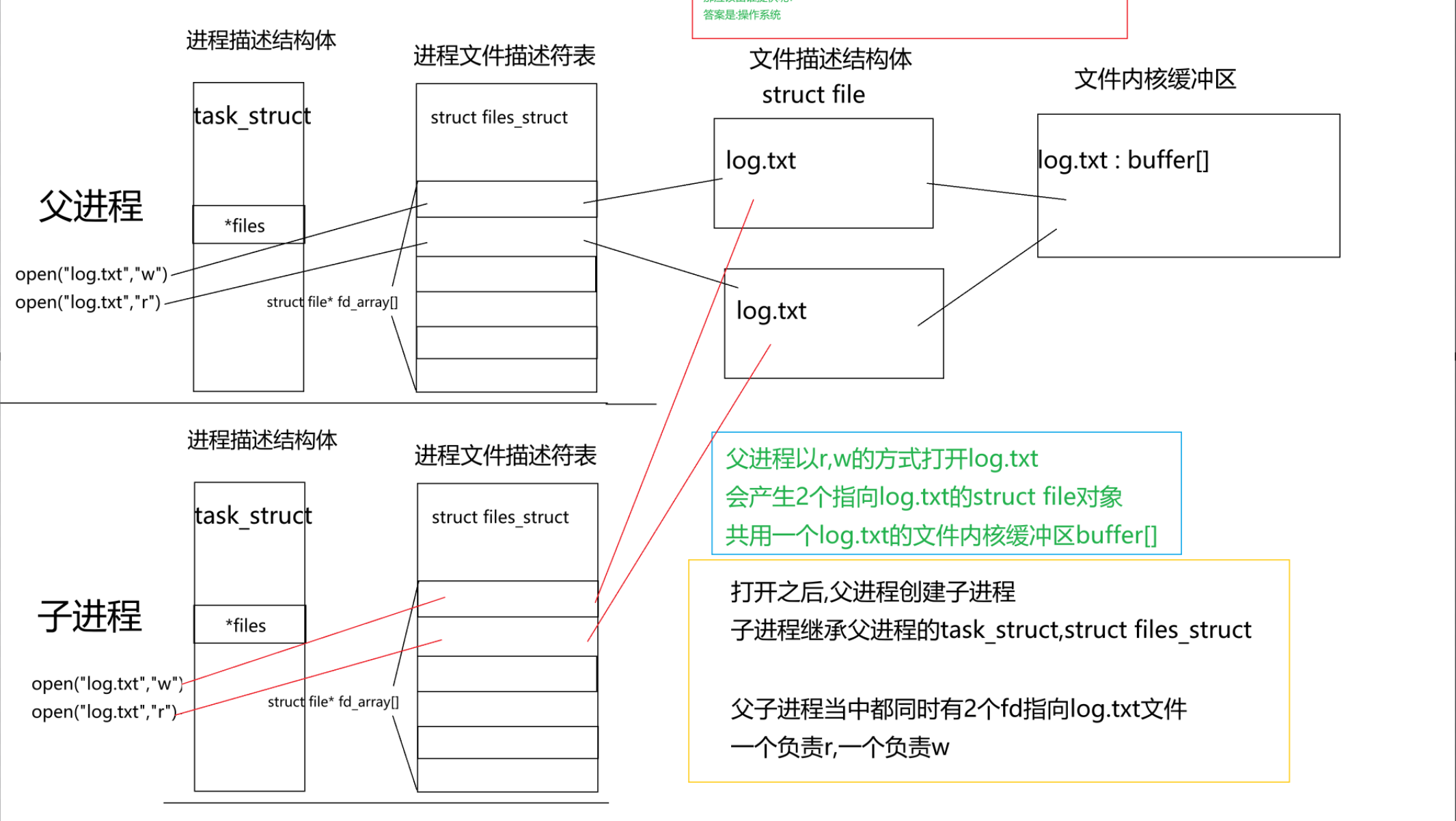
创建子进程之后log.txt的struct file对象的引用计数++
此时父子进程都对log.txt这个文件同时具有读写权限
也就是说父子进程看到了同一份资源(log.txt),这就是进程间通信
此时如果子进程对log.txt进行写入,父进程对log.txt进行读取
这不就完成了进程间通信了吗?
因此,这种
基于文件,让不同进程看到同一份资源的方式,就叫做管道!
如果让父子进程同时对log.txt既有读权限,又有写权限,那不就容易发生混乱吗?
因此设计管道的工程师规定:
管道只能被设计为单向通信!
那么我们如何把刚才的情况改为只能进行单向通信呢?
比方说我们要求父进程作为读端,子进程作为写端
只需要关闭父进程的’w’权限和子进程的’r’权限即可
log.txt的struct file对象的引用计数–
只有当引用计数减为0时,才会释放该struct file对象和其内核缓冲区
此时,父子进程的通信方式就叫做管道!!
回想一下,刚才我们是如何让不同的进程看到同一份资源的呢?
通过创建子进程,子进程会继承父进程的相关属性信息
子进程继承了父进程的相关信息,子进程的子进程也会继承子进程的相关信息
那么子进程的子进程不就也能跟父进程进行进程间通信了吗?
是的,因此进程之间只要具有血缘关系,那么就可以利用管道来进行进程间通信
而如果没有血缘关系,那么就无法利用管道来进行进程间通信了
三.匿名管道
如果此时我们想要让两个进程之间进行通信,但是不想在磁盘当中建立单独的文件,怎么办呢?
此时就可以使用匿名管道了
匿名管道:只能让具有血缘关系的进程之间进行进程间通信(常用于父子进程)
(祖先跟后代可以,兄弟之间也可以哦)
如何利用呢?
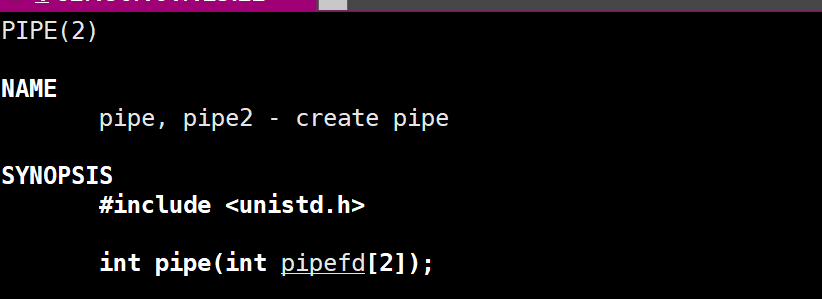
pipe这个函数就是用来创建匿名管道的,传入的参数是一个数组,是一个输出型参数
执行该函数后,会得到2个fd,分别存储在pipefd[0]和pipefd[1]的位置
pipefd[0]存储的是负责r(读)的fd,pipefd[1]存储的是负责w(写)的fd
pipe所创建的匿名管道是一个内存级的文件,并不存在于磁盘当中!!
创建成功返回值为0,创建失败返回值小于0
1.验证代码
下面我们来写一个验证代码

这份代码的含义是:
1.创建管道
2.创建子进程
3.子进程死循环向管道当中写入数据
4.父进程死循环从管道当中读取数据
然后我们编译生成可执行程序,开始运行
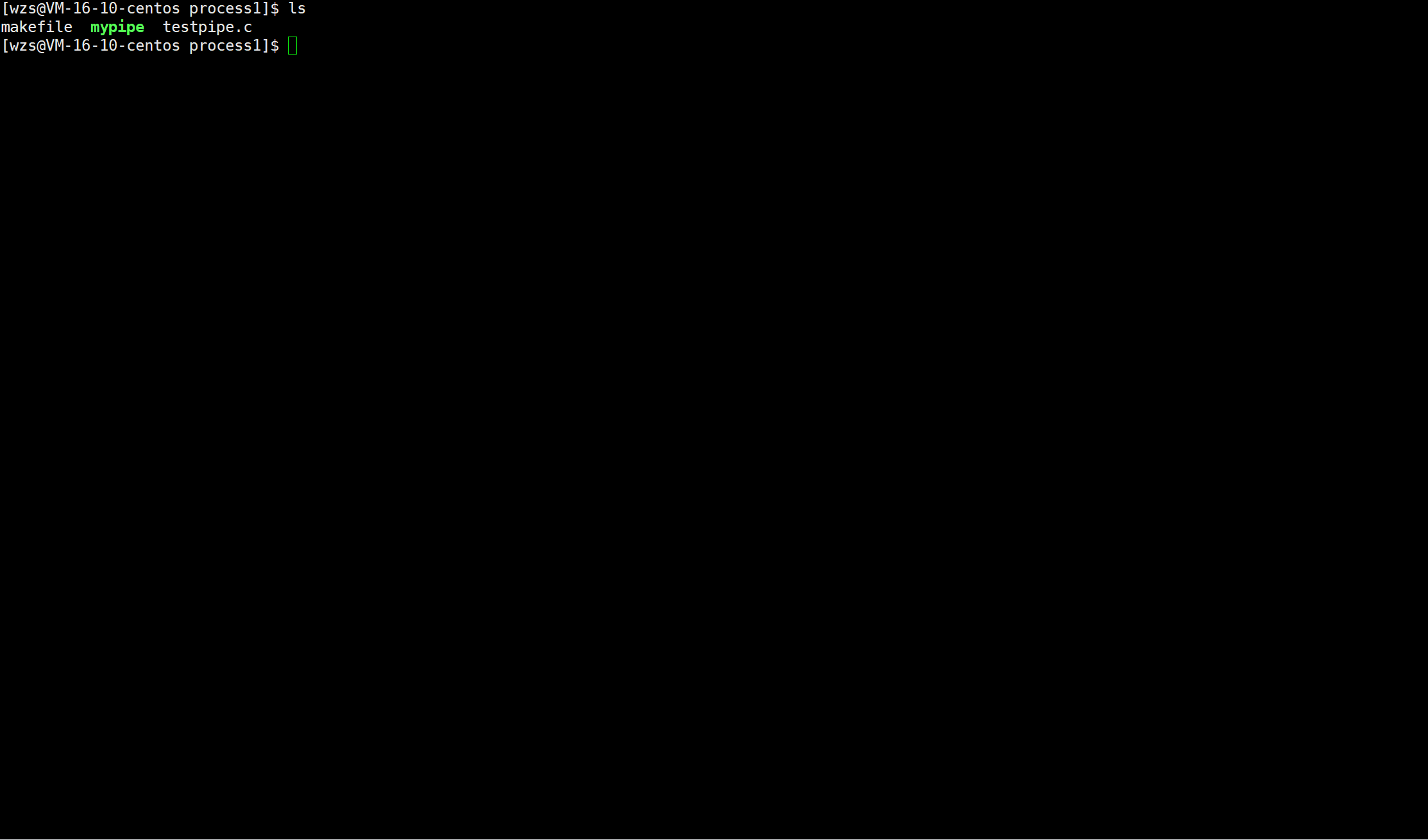
至此我们验证完毕
2.四种情况
经过刚才的演示,我们知道父子进程是如何通过管道来进行通信的了
但是还是不够细节,因为有些情况没有涉及到,下面我们来一一看看这4种情况吧

为了方便演示,我们改一下代码,让子进程发送消息时每次少发一些
不着急,我们一一分析
1.写端不写,且不退
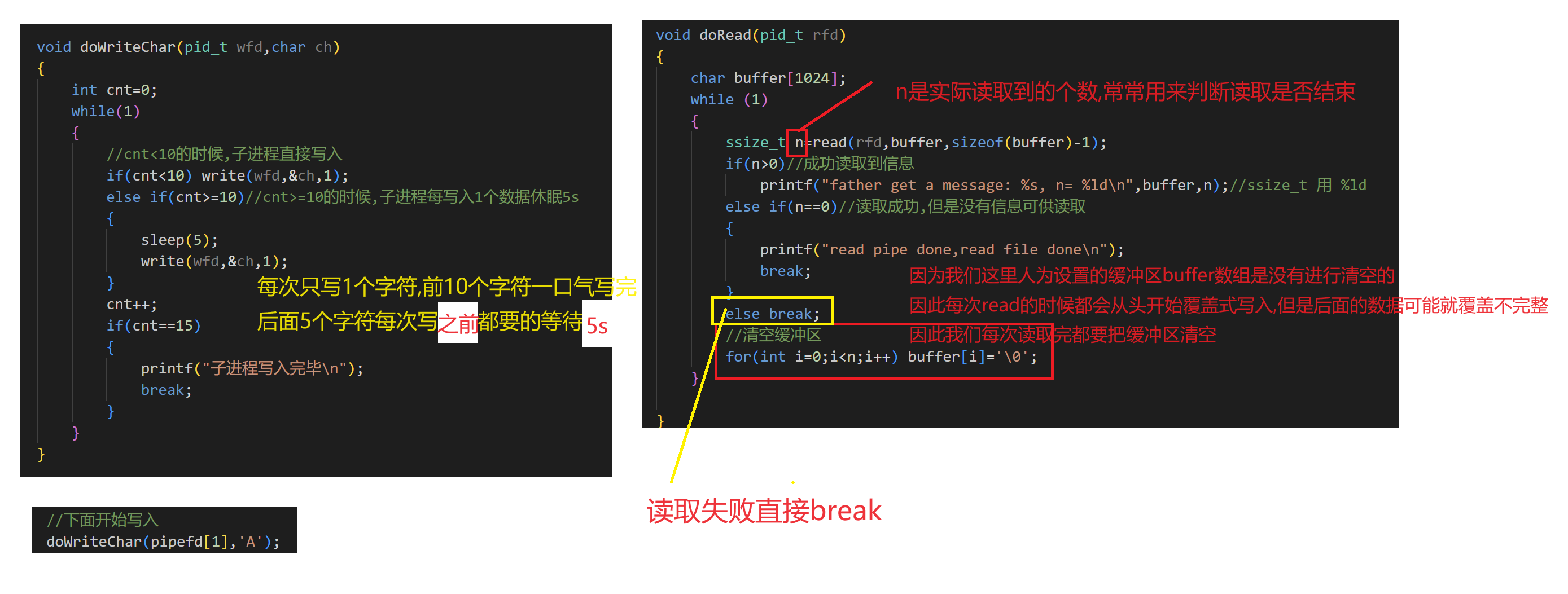


2.读端不读,且不退
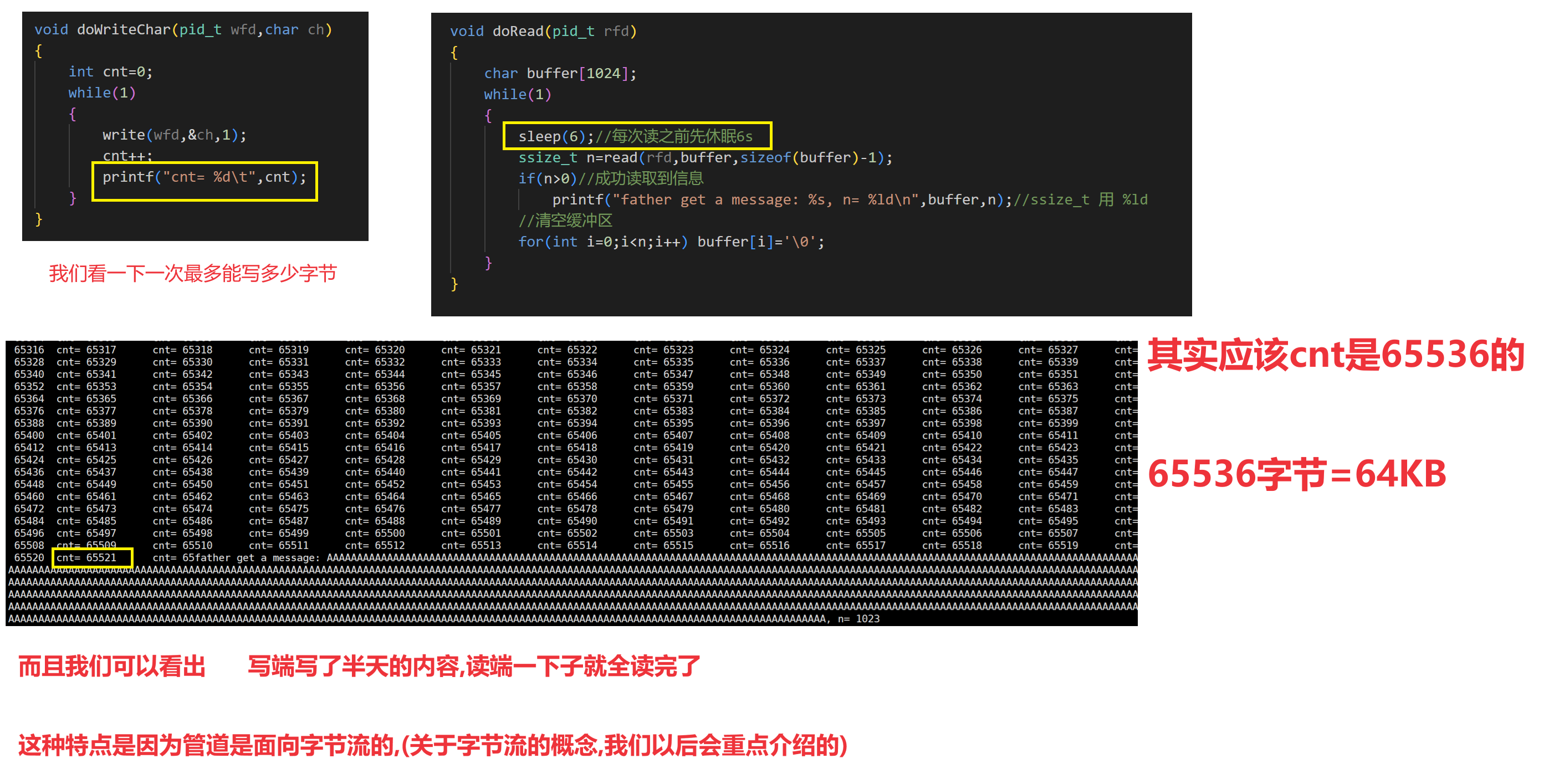
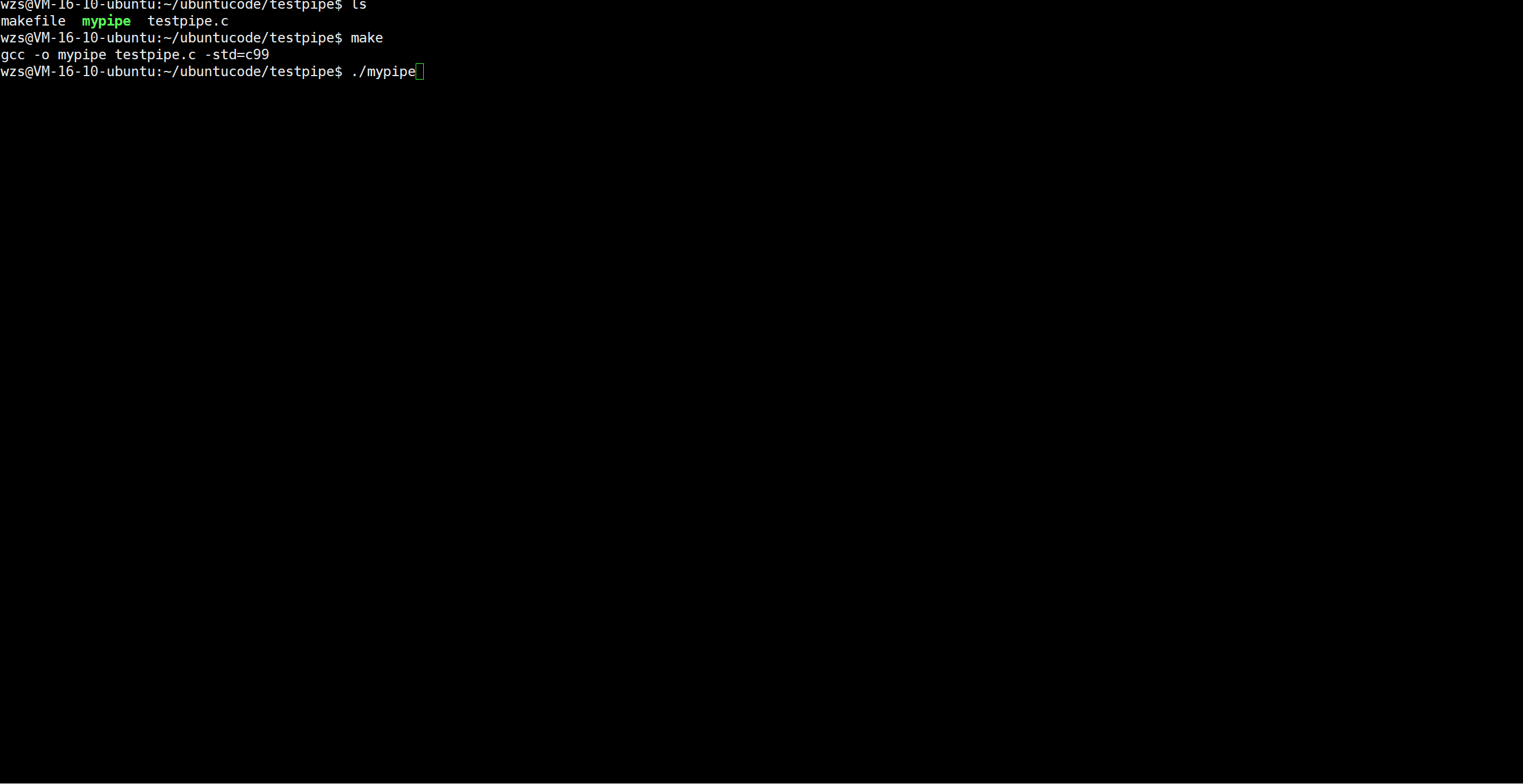

补充一点:

PIPE_BUF:管道的缓存大小是4096字节
当要写入的数据量不大于PIPE_BUF时,Linux将保证写入的原子性
当要写入的数据量大于PIPE_BUF时,Linux将不再保证写入的原子性
关于原子性我们以后会还会见到的

3.写端不写,退了
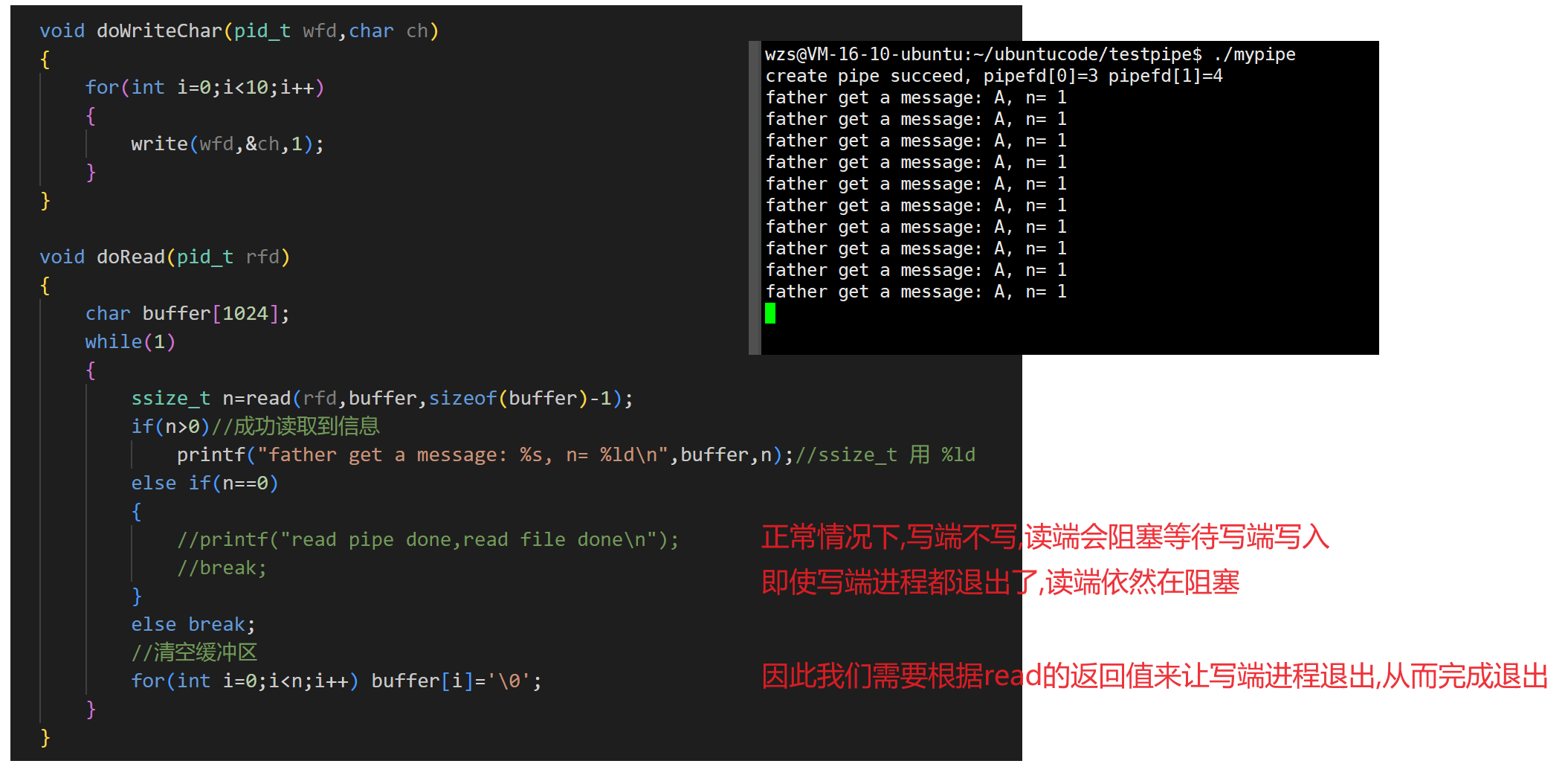
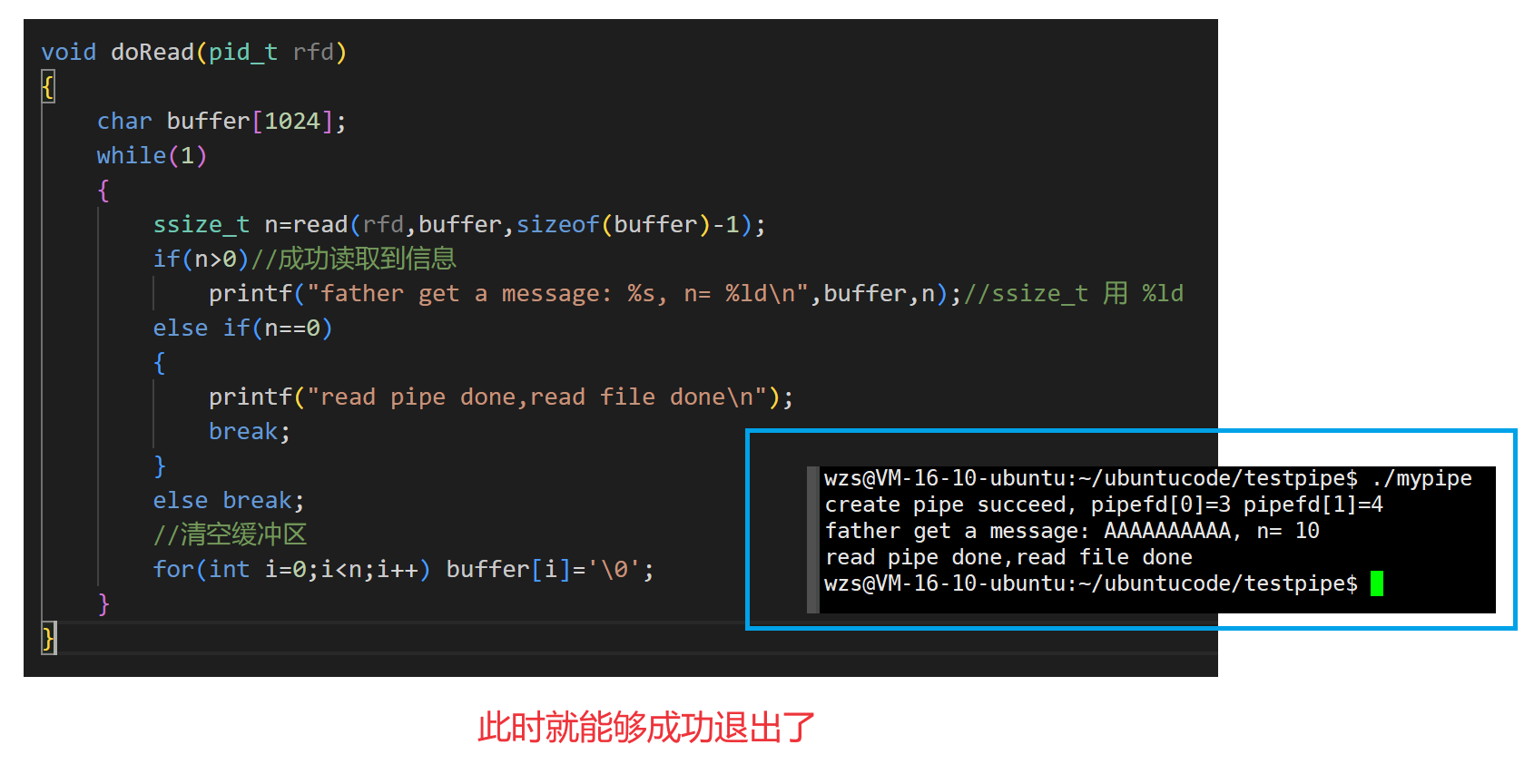


4.读端不读,退了
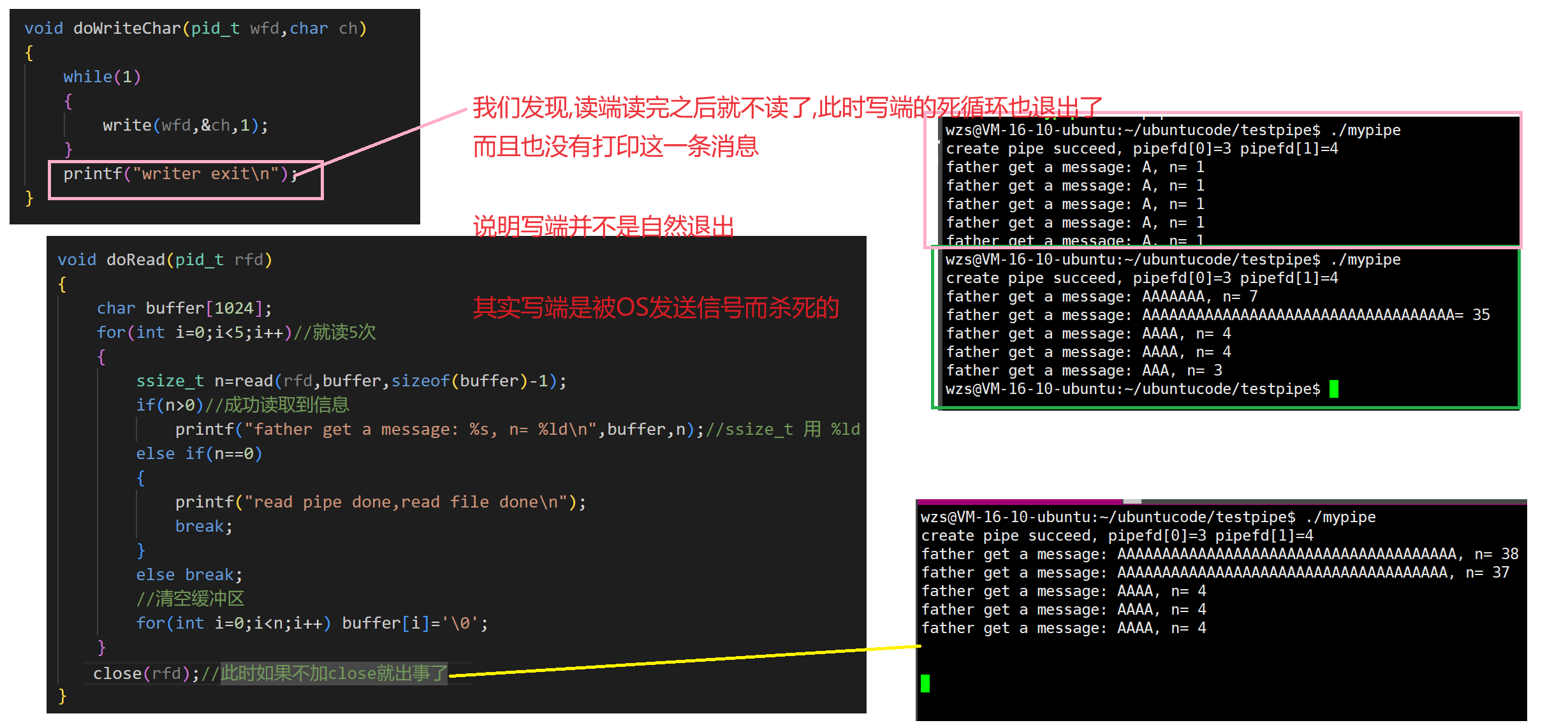
其实发送的是13号信号:
SIGPIPE
验证:
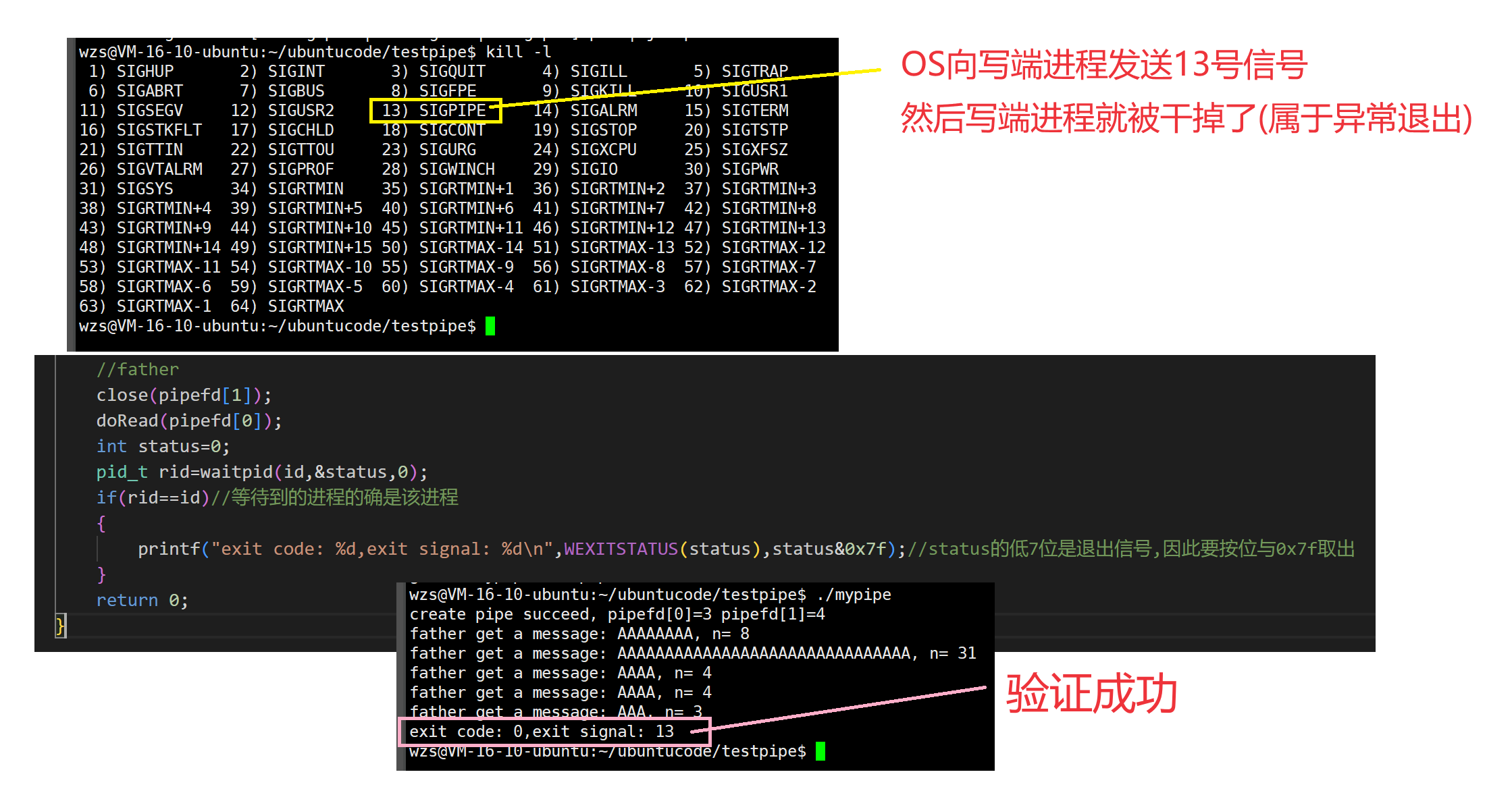

5.小小总结
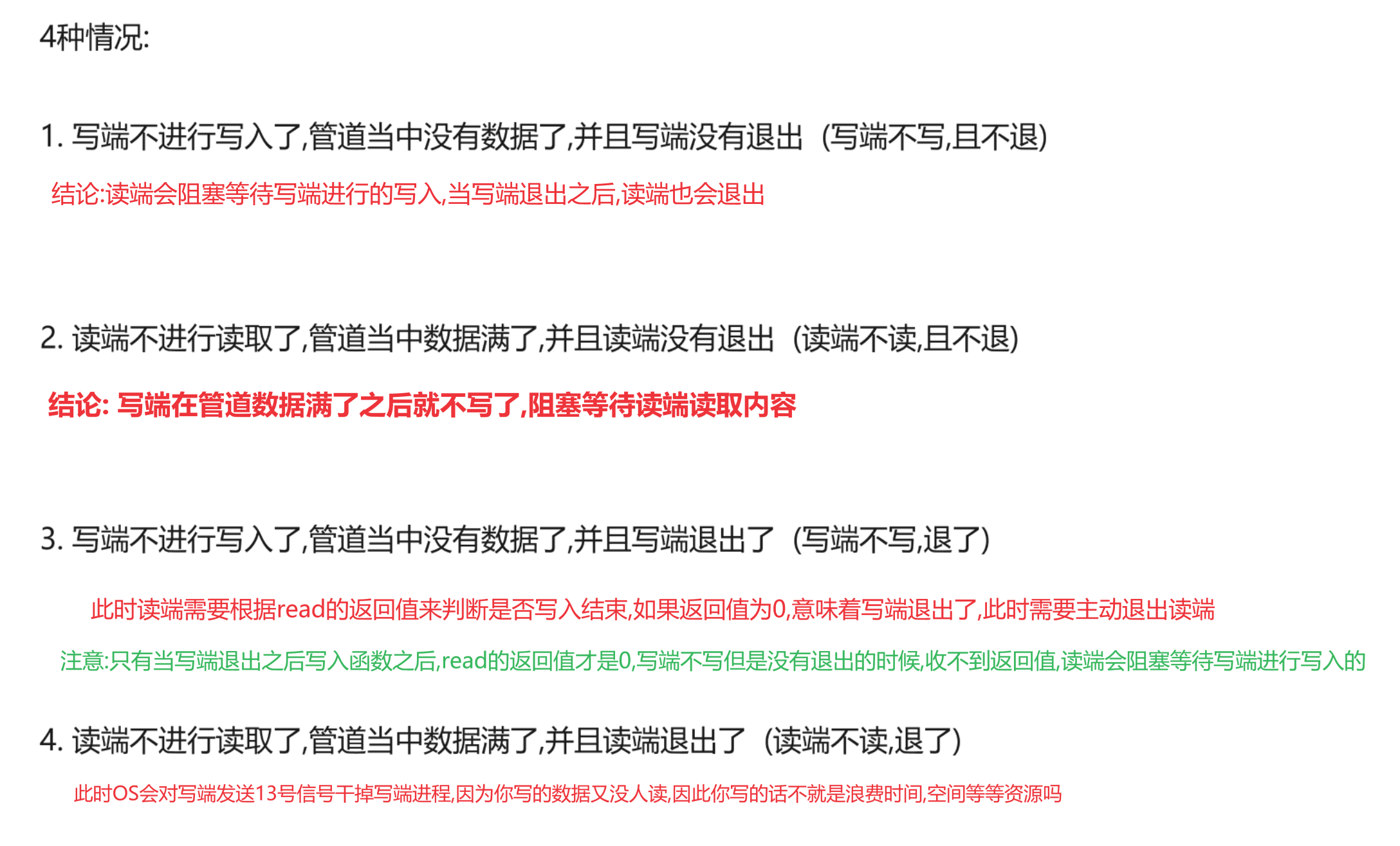
3.五种特性
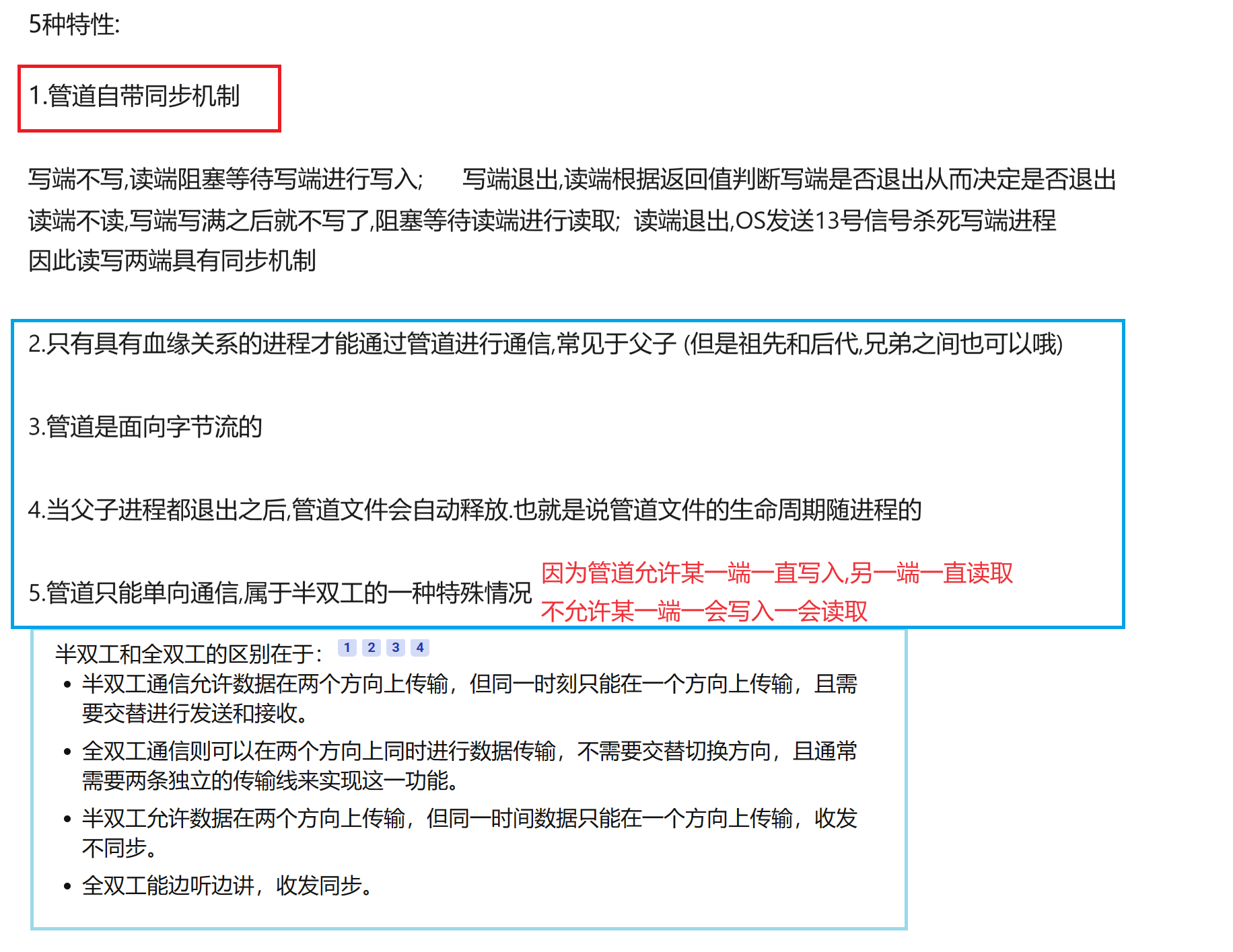
4.理解命令行管道
我们之前在Linux常见指令2当中介绍过命令行管道的使用
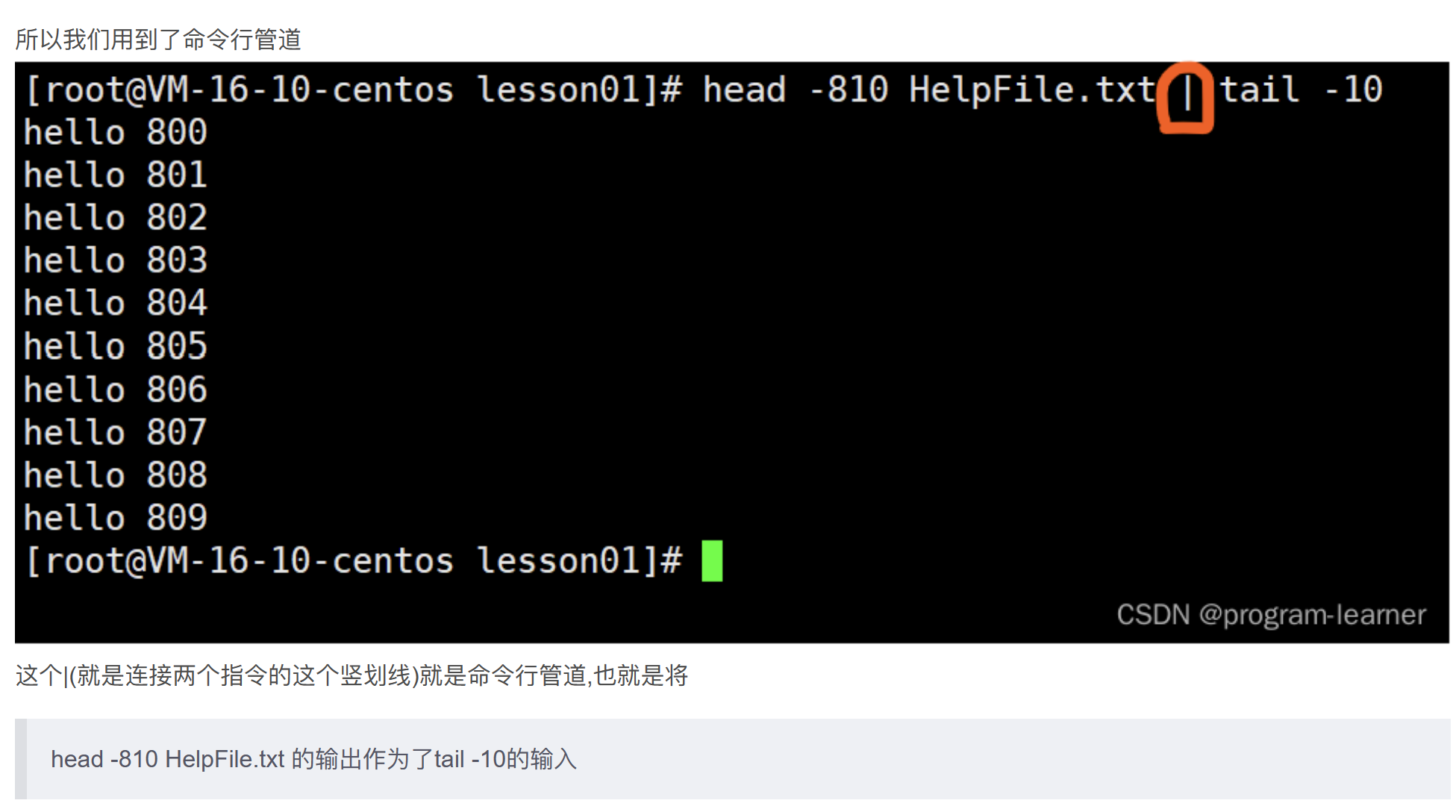
而今天我们学习了管道之后,我们再回过头来重新认识一下命令行管道
ps ajx | head -1 && ps ajx | grep 可执行程序名字 | grep -v grep
- 1
还记得我们的监控脚本吗?
其实它就是一个命令行管道的典型应用
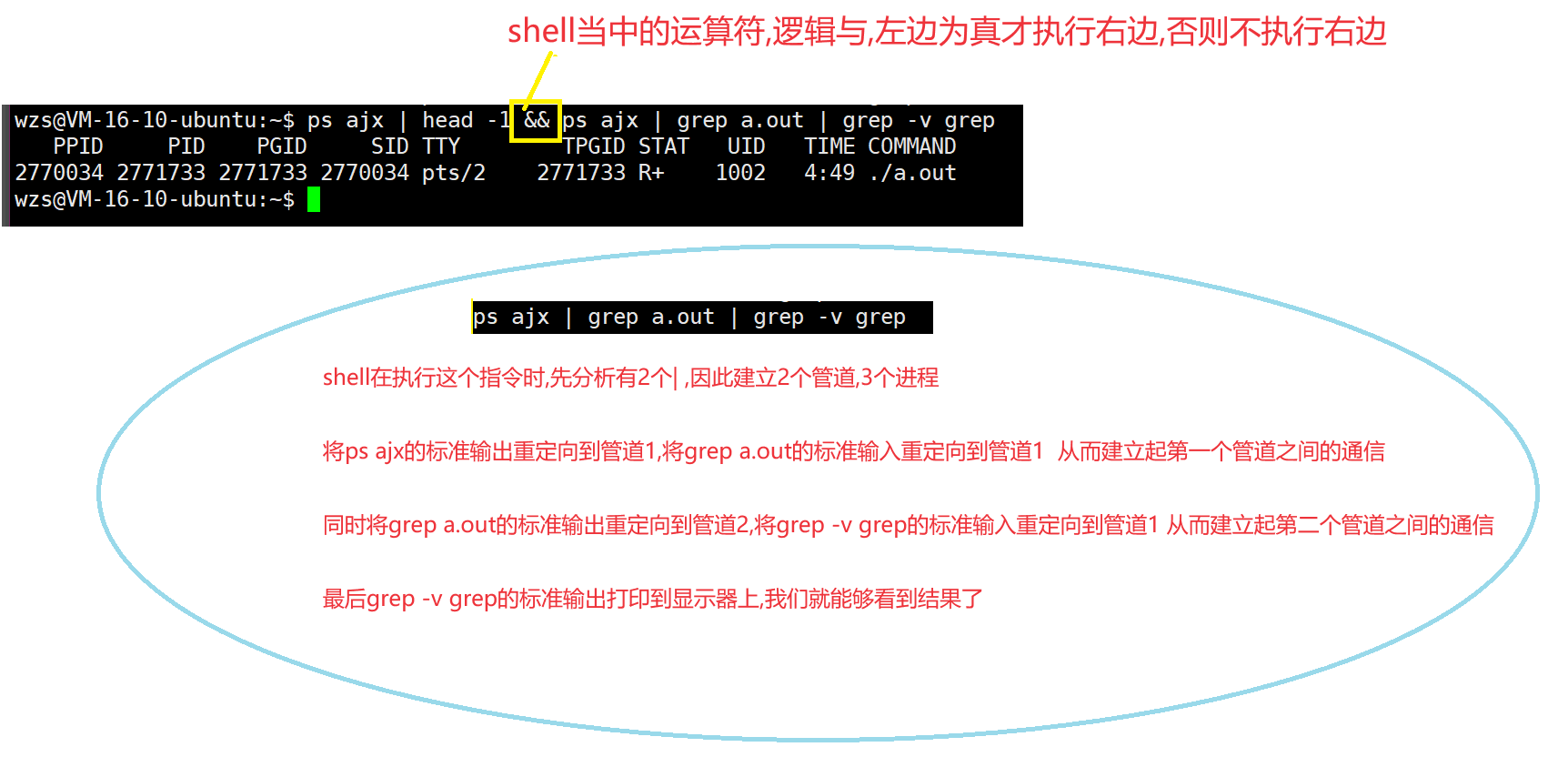
四.命名管道
匿名管道挺好的,只不过只能由具有血缘关系的进程才能够使用,还是有些局限性的
能不能让没有血缘关系的进程之间也能使用管道来通信呢?
是可以的,不过需要使用我们接下来要介绍的命名管道
1.理论
1.回顾匿名管道的原理

2.命名管道理论

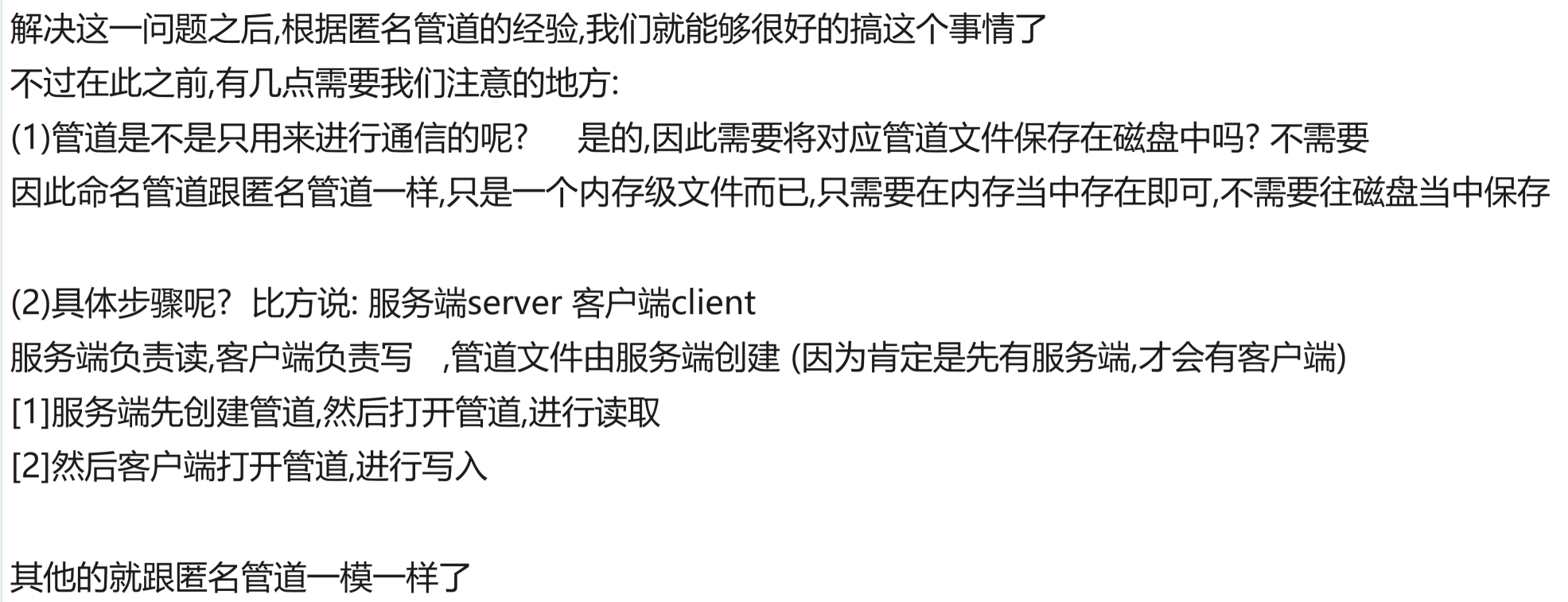
2.系统调用接口的介绍与使用
1.介绍
跟匿名管道一样,这件事情OS不放心让用户完成,也是为了给用户一个良好的使用体验,因此OS提供了系统调用接口
mkfifo
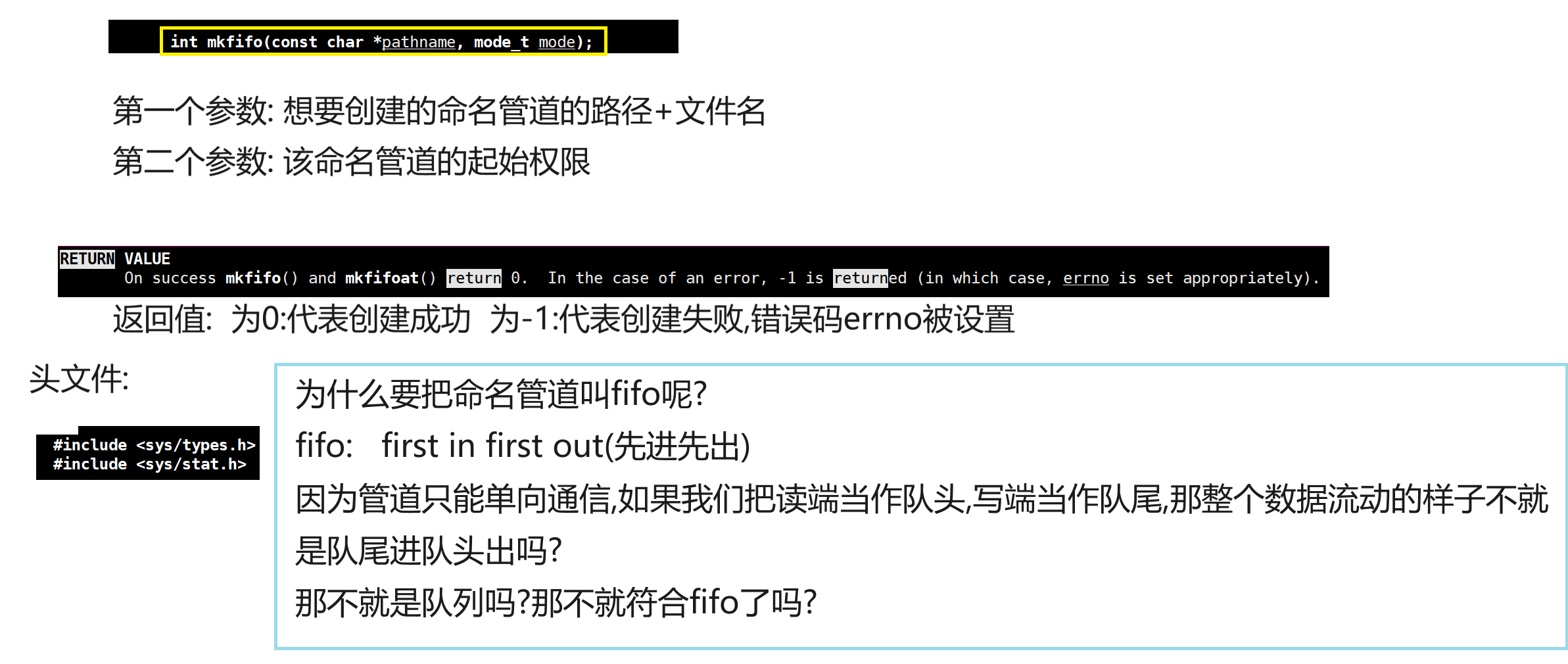
2.使用
我们知道|是命令行当中的匿名管道,说明Linux支持在命令行当中创建匿名管道,那么命名管道呢?
如果不允许的话,Linux是不是就有点偏心了啊
Linux也允许在命令行当中使用mkfifo来创建命名文件
曾记否:我们之前在介绍Linux下的文件类型的时候见过这个管道文件哦
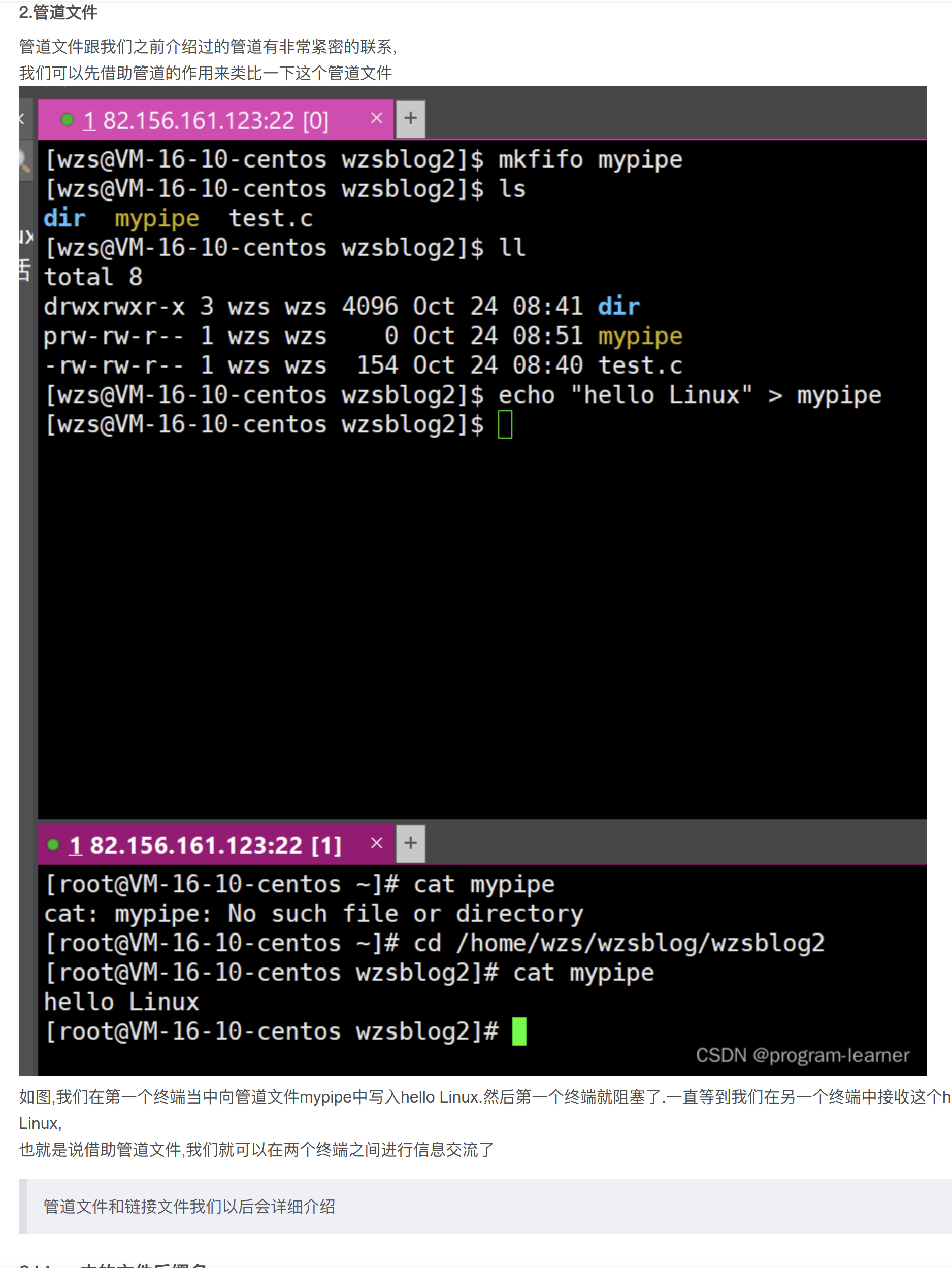
今天我们想说的是:创建了一个命名管道之后,就不能再创建同名的命名管道了

因此我们在创建了命名管道之后,当本次客户端和服务端通信结束之后,为了让下一次对应的代码还能正常运行(也就是创建命名管道成功)
而且肯定是客户端先退出,所以我们要在服务端退出时将这个命名管道删掉
如何删呢?总不能进程程序替换执行个rm -f xxx命名管道吧,那也太挫了吧
OS肯定要提供系统调用接口


同样的unlink也是一个指令哦
介绍完我们需要使用的新增的系统调用接口之后,下面我们来搞代码啦
3.代码编写
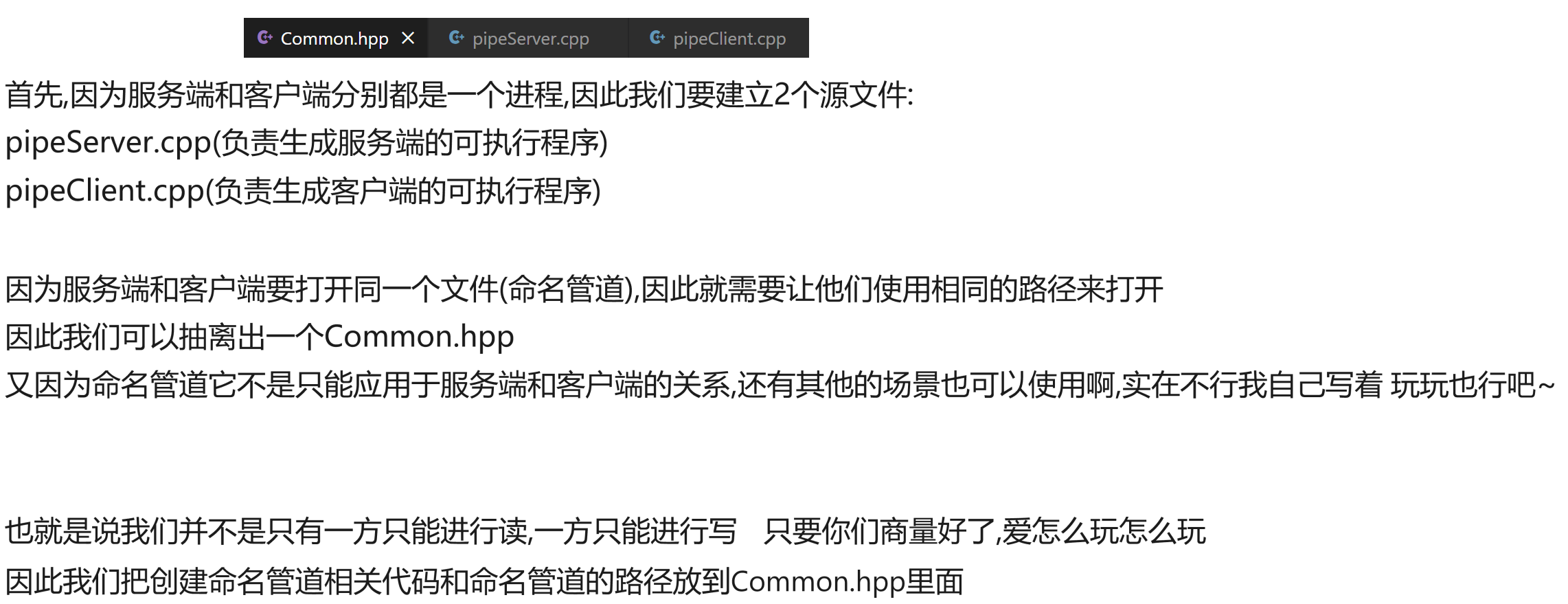
这里unlink,read,write,open等等都要判断是否成功,这里为了让代码更加简洁,就没怎么判断,大家可以加上,返回错误码是真的难受…
还是异常香
1.Common.hpp
命名管道是不是只有一份呢?
不是,可以同时有很多份,OS要不要管理,要
如何管理?先描述,在组织
走起
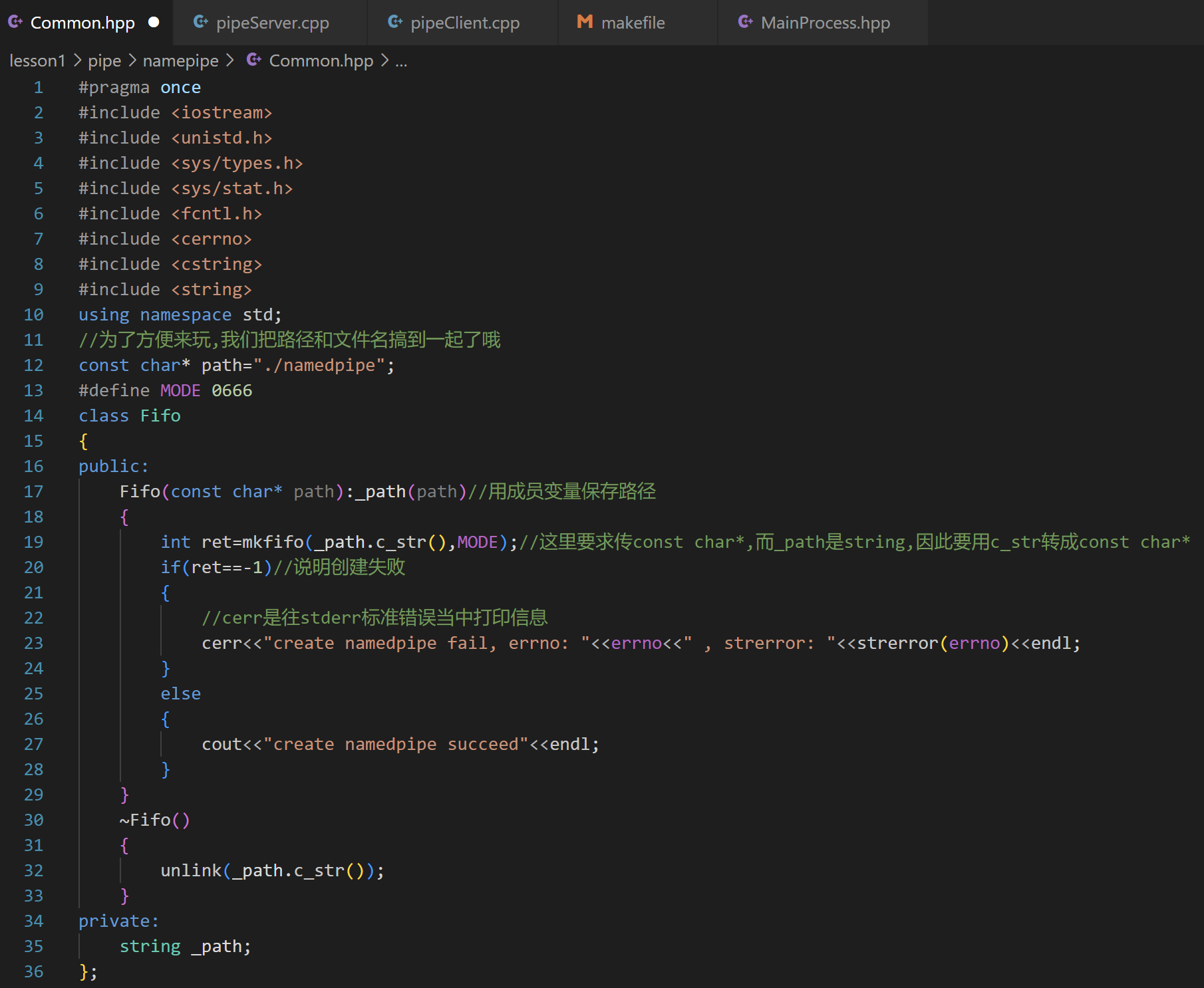
2.pipeServer.cpp
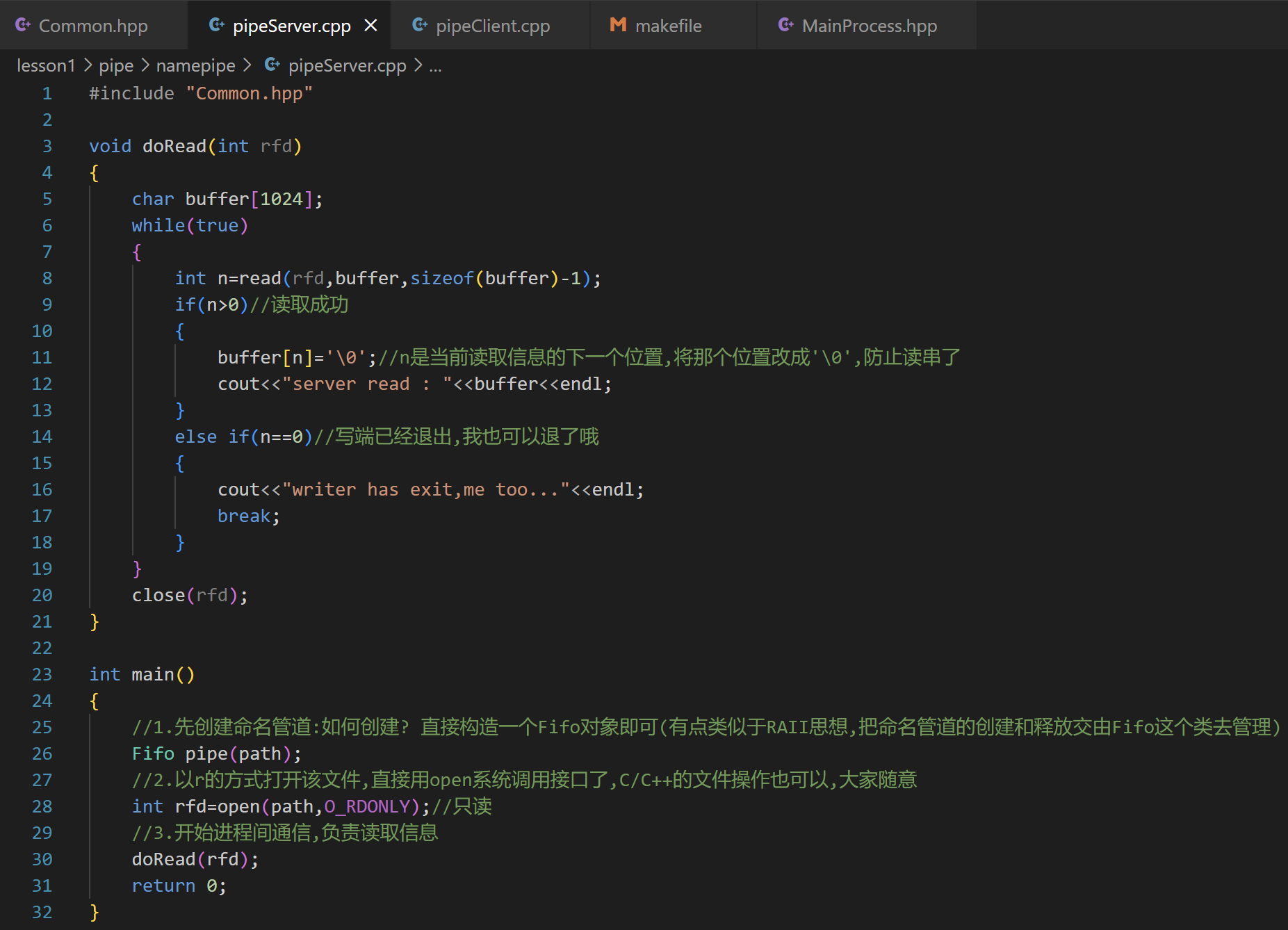
注意:
命名管道创建之后
如果只有读端被打开了,写端还没有被打开,那么读端会阻塞在open函数当中
如果只有写端被打开了,读端还没有被打开,那么写端会阻塞在open函数当中
3.pipeClient.cpp
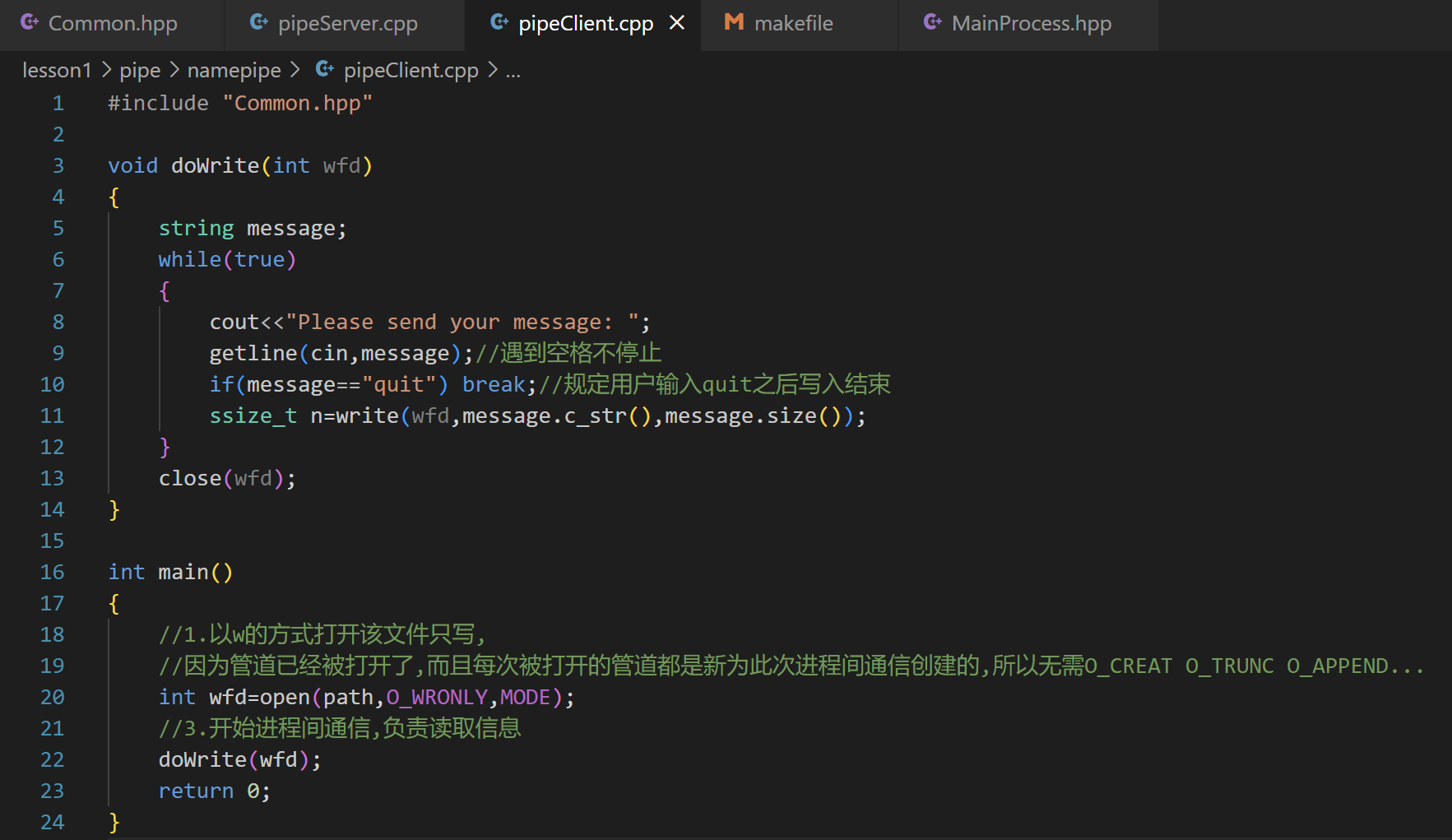
4.makefile
因为要生成2个可执行程序,因此需要用一个伪目标
(当然你make xxx两次也可以,主要是不优雅)
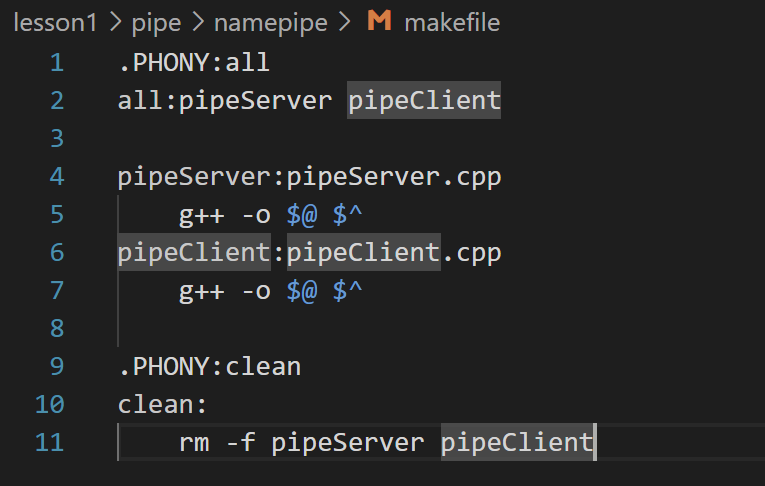
4.动图演示
此时就能够随便玩了
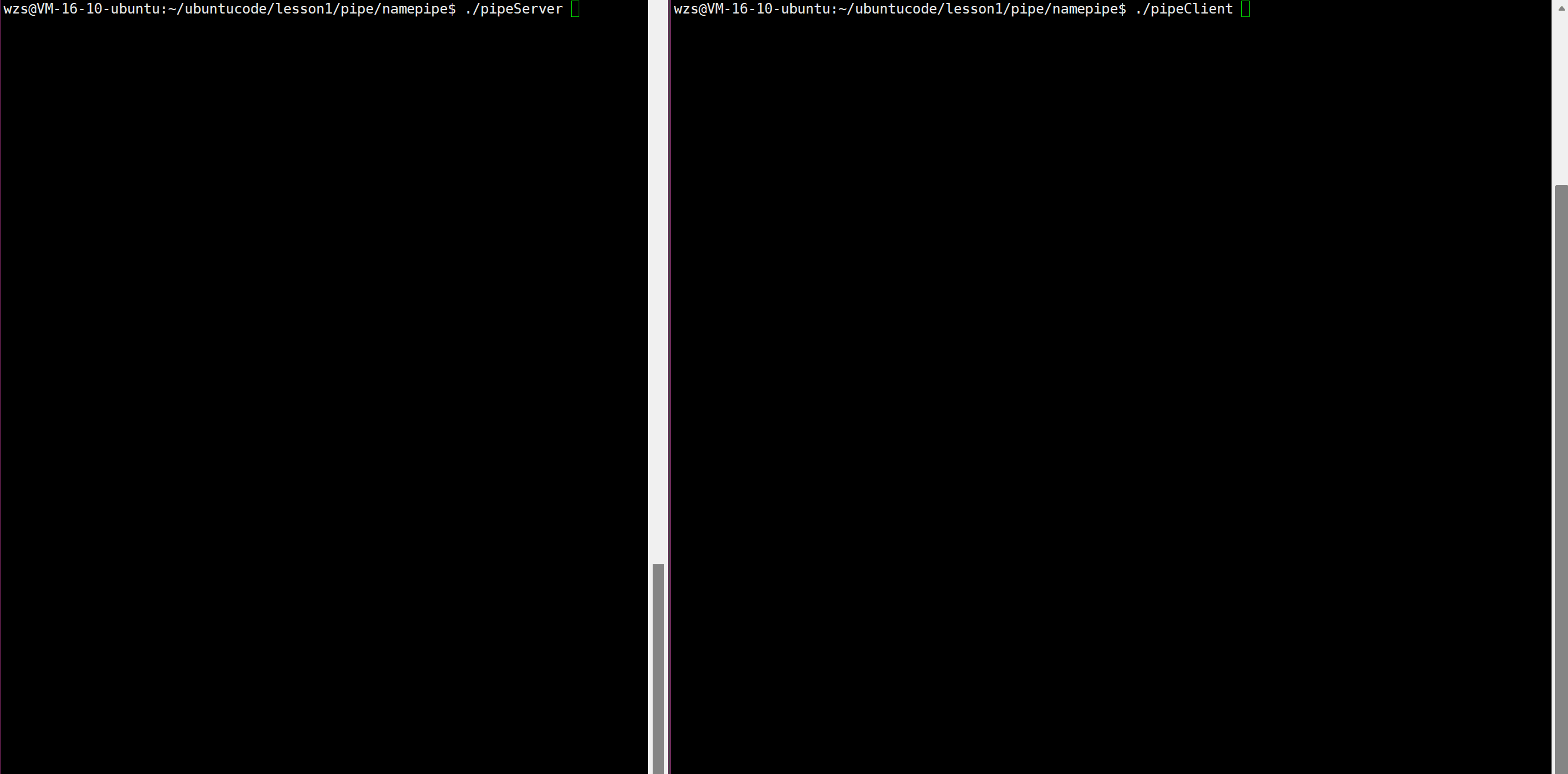
当然你要是想换一下读写端的话,两个人约定一些暗号等等的信息,输入之后就先暂时退出,然后各自换一种权限打开该文件等等,
这一点上面比匿名管道好玩总之,你想怎么玩就怎么写
随意~
五.自定义shell当中添加命令行管道的功能
1.前言
前言 : 有些内建命令的确可以跟命令行管道一起使用,例如echo,不过某些内建命令无法跟命令行管道一起使用:比如cd
命令行管道可以跟重定向>>,>,<一起使用
拿出我们实现完重定向的shell,(我今天是由自己写了一遍,所以跟上一次的有些不同,但功能是一样的,大家知道能这么玩就行,有空的时候可以自己玩一下)
(还有就是那个echo $?返回最近一次错误码,因为最近刚学了异常,所以看到这种错误码就浑身难受,所以没有搞这个,不过不妨碍我们今天要实现的重定向)
这是一个cpp文件(因为如果用C添加命令行管道[太麻烦了,连个顺序表都没有]…写C++写惯了,不想用C…)
为了方便实现,我们把main函数中的代码拿出去了两部分
代码:
#include <stdio.h> #include <stdlib.h> #include <string.h> #include <unistd.h> #include <sys/wait.h> #include <sys/types.h> #include <sys/stat.h> #include <ctype.h> #include <fcntl.h> #include <vector> #include <iostream> #define NoneRedir 0 #define OutputRedir 1 #define InputRedir 2 #define AppendRedir 3 using namespace std; int lastcode=0;//上一次进程退出时的退出码 int redir=NoneRedir; char* filename=NULL; char cwd[1024]={'\0'}; char env[1024][1024]={'\0'}; int my_index=0; //将字符串s按照空格作为分割符拆分后添加到vs当中(不过: 空格可能会连续出现) void CommandLineSplit(char* command,char* commandV[]) { char* s=strtok(command," "); commandV[0]=s; int i=1; while(commandV[i++]=strtok(NULL," ")){} } #define SkipSpace(pos) do{while(isspace(*pos)){pos++;}}while(0) void CheckRedir(char* command) { int len=strlen(command); char* pos; for(int i=len-1;i>=0;) { if(command[i]=='>') { if(i>0 && command[i-1]=='>')//追加 { redir=AppendRedir; command[i-1]='\0'; } else//输出 { redir=OutputRedir; command[i]='\0'; } pos=command+i+1; SkipSpace(pos); filename=pos; break; } else if(command[i]=='<')//输入 { redir=InputRedir; command[i]='\0'; pos=command+i+1; SkipSpace(pos); filename=pos; break; } else { i--; } } } void Exec(char* commandV[]) { pid_t id=fork(); if(id==0) { if(redir==InputRedir) { int fd=open(filename,O_RDONLY); dup2(fd,0); } else if(redir==OutputRedir) { int fd=open(filename,O_WRONLY | O_CREAT | O_TRUNC,0666); dup2(fd,1); } else if(redir==AppendRedir) { int fd=open(filename,O_WRONLY | O_CREAT | O_APPEND,0666); dup2(fd,1); } execvp(commandV[0],commandV); } wait(NULL); } void cd(char* path) { chdir(path); char tmp[1024]={'\0'}; getcwd(tmp,sizeof(tmp)); sprintf(cwd,"PWD=%s",tmp); putenv(cwd); } void Export(char* s) { strcpy(env[my_index],s); putenv(env[my_index++]); } int echo(char* commandV[]) { //1.echo后面什么都没有,相当于'\n' if(commandV[1]==NULL) { printf("\n"); lastcode=0; return 1; } //2.echo $? echo $PWD echo $ char* cmd=commandV[1]; int len=strlen(cmd); if(cmd[0]=='$' && len>1) { //echo $? if(cmd[1]=='?') { printf("%d\n",lastcode); lastcode=0; } //echo $PWD else { char* tmp=cmd+1; const char* env=getenv(tmp); //找不到该环境变量,打印'\n',退出码依旧为0 if(env==NULL) { printf("\n"); } else { printf("%s\n",env); } lastcode=0; } } else { if(cmd[0]=='"' && cmd[len-1]=='"') { cmd[len-1]='\0'; printf("%s\n",cmd+1); } else printf("%s\n",cmd); } return 1; } int doBulidIn(char* commandV[]) { int ret=0; if(strcmp(commandV[0],"cd")==0) { cd(commandV[1]); ret=1; } else if(strcmp(commandV[0],"export")==0) { Export(commandV[1]); ret=1; } else if(strcmp(commandV[0],"echo")==0) { echo(commandV); ret=1; } return ret; } //打印提示符和修正redir,filename的函数 void step1() { redir=NoneRedir; filename=NULL; //1.打印提示符wzs@VM-16-10-ubuntu:~/ubuntucode/shell$ printf("%s@VM-16-10-ubuntu:%s$ ",getenv("USER"),getenv("PWD")); } //具体执行指令的函数 void step3(char* command) { //3.检查重定向 CheckRedir(command); //4.解析字符串 char* commandV[1024]={NULL}; CommandLineSplit(command,commandV); //5.分析内建命令 int ret=doBulidIn(commandV); if(ret==0) { //6.进程程序替换 Exec(commandV); } } int main() { while(1) { step1(); char command[1024]={'\0'}; fgets(command,sizeof(command),stdin); int len=strlen(command); command[len-1]='\0'; step3(command); } return 0; }
- 1
- 2
- 3
- 4
- 5
- 6
- 7
- 8
- 9
- 10
- 11
- 12
- 13
- 14
- 15
- 16
- 17
- 18
- 19
- 20
- 21
- 22
- 23
- 24
- 25
- 26
- 27
- 28
- 29
- 30
- 31
- 32
- 33
- 34
- 35
- 36
- 37
- 38
- 39
- 40
- 41
- 42
- 43
- 44
- 45
- 46
- 47
- 48
- 49
- 50
- 51
- 52
- 53
- 54
- 55
- 56
- 57
- 58
- 59
- 60
- 61
- 62
- 63
- 64
- 65
- 66
- 67
- 68
- 69
- 70
- 71
- 72
- 73
- 74
- 75
- 76
- 77
- 78
- 79
- 80
- 81
- 82
- 83
- 84
- 85
- 86
- 87
- 88
- 89
- 90
- 91
- 92
- 93
- 94
- 95
- 96
- 97
- 98
- 99
- 100
- 101
- 102
- 103
- 104
- 105
- 106
- 107
- 108
- 109
- 110
- 111
- 112
- 113
- 114
- 115
- 116
- 117
- 118
- 119
- 120
- 121
- 122
- 123
- 124
- 125
- 126
- 127
- 128
- 129
- 130
- 131
- 132
- 133
- 134
- 135
- 136
- 137
- 138
- 139
- 140
- 141
- 142
- 143
- 144
- 145
- 146
- 147
- 148
- 149
- 150
- 151
- 152
- 153
- 154
- 155
- 156
- 157
- 158
- 159
- 160
- 161
- 162
- 163
- 164
- 165
- 166
- 167
- 168
- 169
- 170
- 171
- 172
- 173
- 174
- 175
- 176
- 177
- 178
- 179
- 180
- 181
- 182
- 183
- 184
- 185
- 186
- 187
- 188
- 189
- 190
- 191
- 192
- 193
- 194
- 195
- 196
- 197
- 198
- 199
- 200
- 201
- 202
- 203
- 204
- 205
- 206
- 207
- 208
- 209
- 210
- 211
- 212
- 213
- 214
- 215
- 216
- 217
- 218
- 219
- 220
- 221
- 222
- 223
- 224
- 225
- 226
2.思路
1.如何创建管道与进程
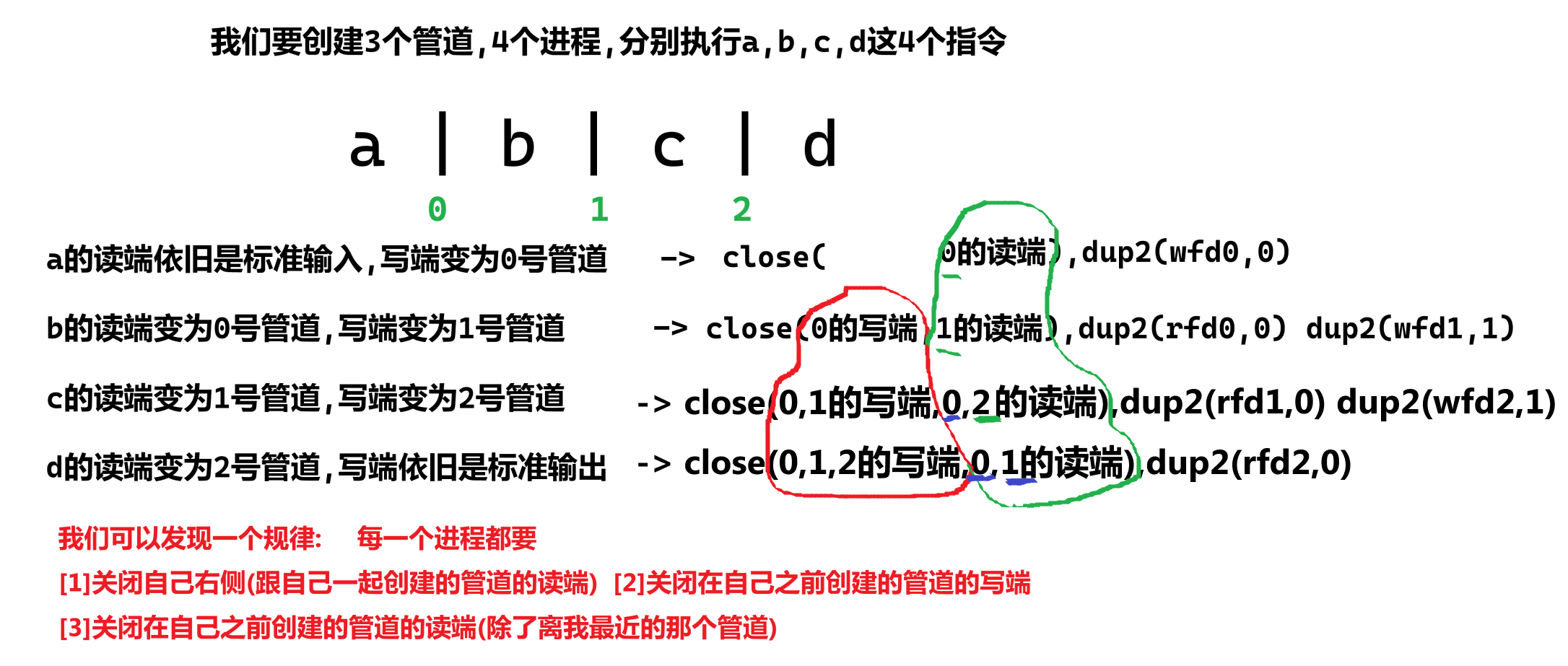
因此,我们只需要边创建管道,边创建进程,(最后一个进程单独创建)
并且用vector<pair<int,int>>存储所有的管道的读写端方便后续管道对其进行关闭
(因为管道的特点是读/写端没有全都退出,另一端就会一直阻塞等待,如果不关闭读写端的话父进程回收时就必须要逆序回收)
又因为我们要让父进程回收子进程,所以在用一个vector<int>存储所有的子进程pid,后续还要waitpid回收他们呢
2.预处理
在检查是否需要重定向之前,我们需要先检查整个字符串有多少个’|‘命令行管道,并且
[1]用一个vector<int>保存它们的位置,并且将对应位置改为’\0’,方便后续把每一块指令传递给子进程去处理
[2]因为第一个指令左侧没有’|',所以我们在初始化vector<int>的时候,可以先存上一个-1,然后分配任务时就好分配了
3.实现
只有刚才的这两步,搞清楚这两点之后代码就能够很好的写出来了
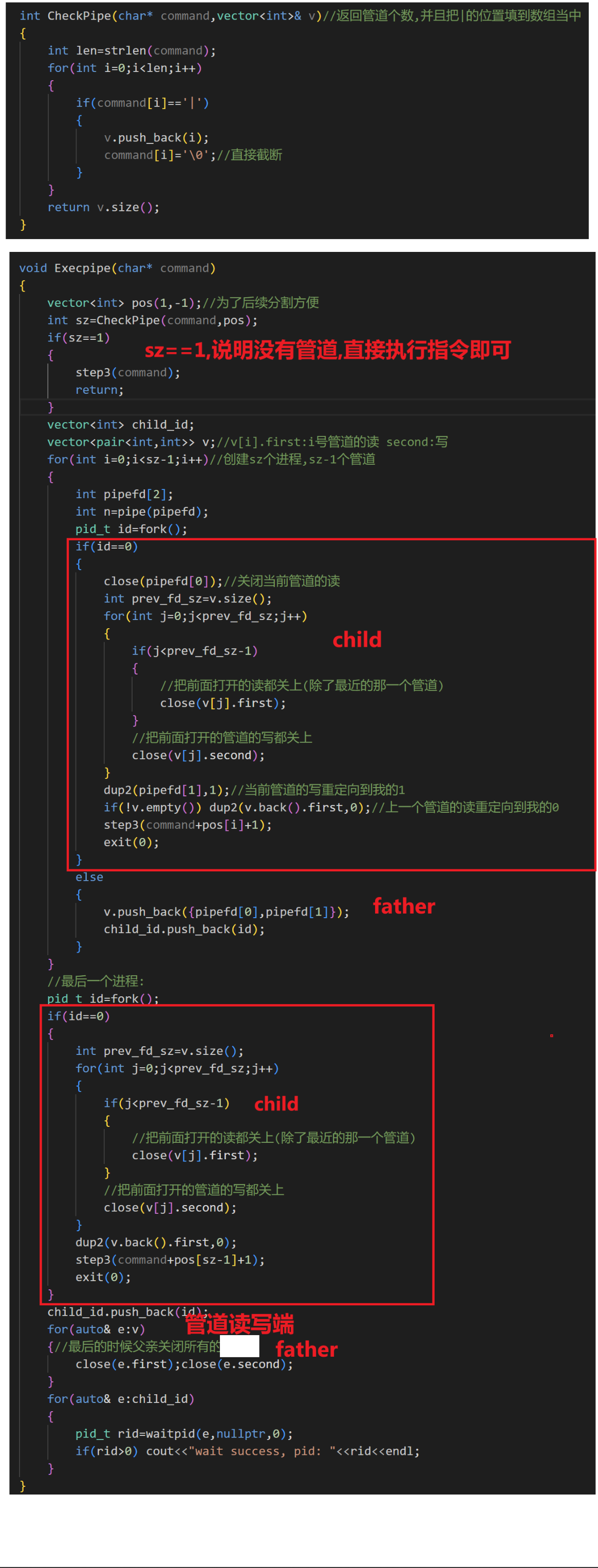
4.演示
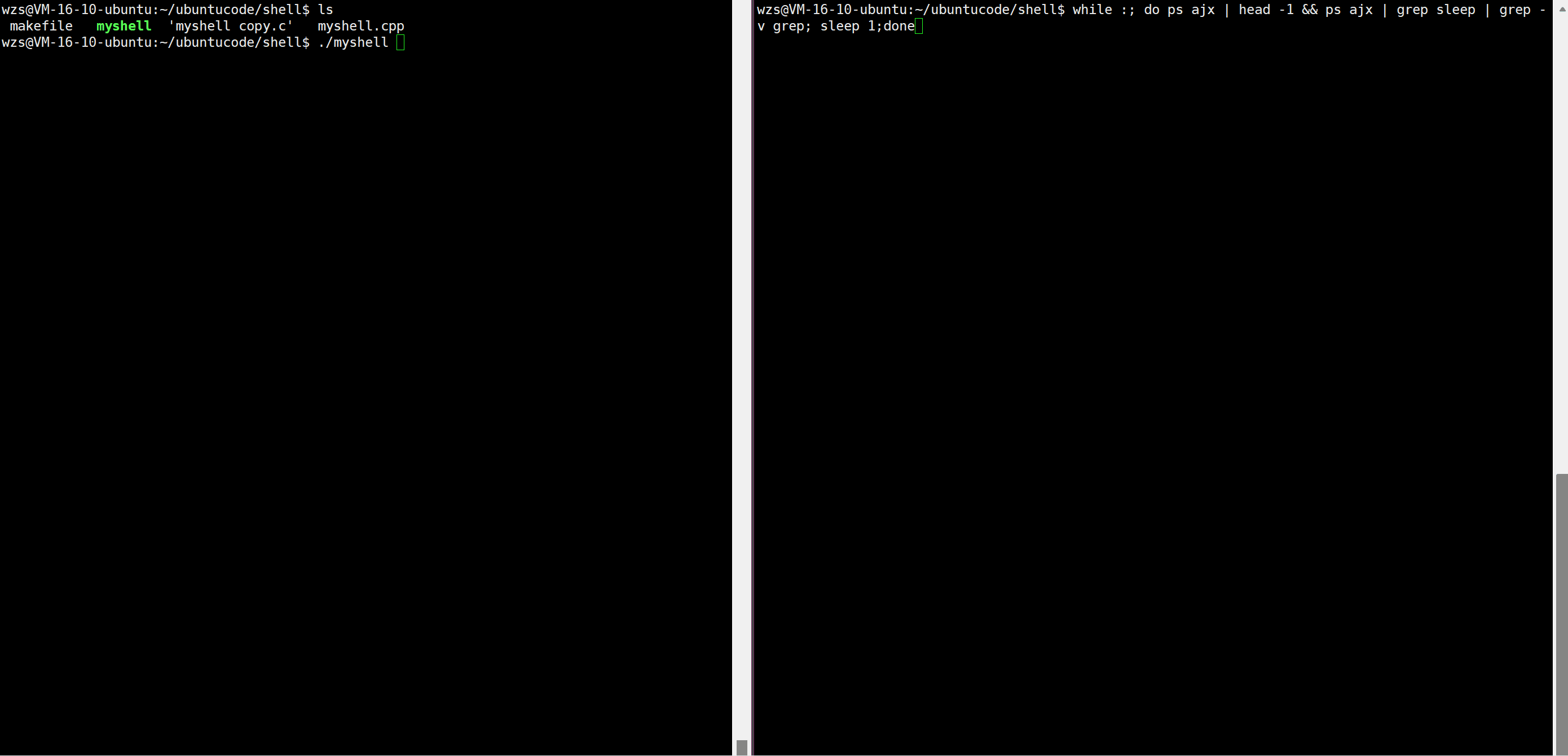
5.代码
#include <stdio.h> #include <stdlib.h> #include <string.h> #include <unistd.h> #include <sys/wait.h> #include <sys/types.h> #include <sys/stat.h> #include <ctype.h> #include <fcntl.h> #include <vector> #include <iostream> #define NoneRedir 0 #define OutputRedir 1 #define InputRedir 2 #define AppendRedir 3 using namespace std; int lastcode=0;//上一次进程退出时的退出码 int redir=NoneRedir; char* filename=NULL; char cwd[1024]={'\0'}; char env[1024][1024]={'\0'}; int my_index=0; //将字符串s按照空格作为分割符拆分后添加到vs当中(不过: 空格可能会连续出现) void CommandLineSplit(char* command,char* commandV[]) { char* s=strtok(command," "); commandV[0]=s; int i=1; while(commandV[i++]=strtok(NULL," ")){} } #define SkipSpace(pos) do{while(isspace(*pos)){pos++;}}while(0) void CheckRedir(char* command) { int len=strlen(command); char* pos; for(int i=len-1;i>=0;) { if(command[i]=='>') { if(i>0 && command[i-1]=='>')//追加 { redir=AppendRedir; command[i-1]='\0'; } else//输出 { redir=OutputRedir; command[i]='\0'; } pos=command+i+1; SkipSpace(pos); filename=pos; break; } else if(command[i]=='<')//输入 { redir=InputRedir; command[i]='\0'; pos=command+i+1; SkipSpace(pos); filename=pos; break; } else { i--; } } } void Exec(char* commandV[]) { pid_t id=fork(); if(id==0) { if(redir==InputRedir) { int fd=open(filename,O_RDONLY); dup2(fd,0); } else if(redir==OutputRedir) { int fd=open(filename,O_WRONLY | O_CREAT | O_TRUNC,0666); dup2(fd,1); } else if(redir==AppendRedir) { int fd=open(filename,O_WRONLY | O_CREAT | O_APPEND,0666); dup2(fd,1); } execvp(commandV[0],commandV); } wait(NULL); } void cd(char* path) { chdir(path); char tmp[1024]={'\0'}; getcwd(tmp,sizeof(tmp)); sprintf(cwd,"PWD=%s",tmp); putenv(cwd); } void Export(char* s) { strcpy(env[my_index],s); putenv(env[my_index++]); } int echo(char* commandV[]) { //1.echo后面什么都没有,相当于'\n' if(commandV[1]==NULL) { printf("\n"); lastcode=0; return 1; } //2.echo $? echo $PWD echo $ char* cmd=commandV[1]; int len=strlen(cmd); if(cmd[0]=='$' && len>1) { //echo $? if(cmd[1]=='?') { printf("%d\n",lastcode); lastcode=0; } //echo $PWD else { char* tmp=cmd+1; const char* env=getenv(tmp); //找不到该环境变量,打印'\n',退出码依旧为0 if(env==NULL) { printf("\n"); } else { printf("%s\n",env); } lastcode=0; } } else { if(cmd[0]=='"' && cmd[len-1]=='"') { cmd[len-1]='\0'; printf("%s\n",cmd+1); } else printf("%s\n",cmd); } return 1; } int doBulidIn(char* commandV[]) { int ret=0; if(strcmp(commandV[0],"cd")==0) { cd(commandV[1]); ret=1; } else if(strcmp(commandV[0],"export")==0) { Export(commandV[1]); ret=1; } else if(strcmp(commandV[0],"echo")==0) { echo(commandV); ret=1; } return ret; } void step1() { redir=NoneRedir; filename=NULL; //1.打印提示符wzs@VM-16-10-ubuntu:~/ubuntucode/shell$ printf("%s@VM-16-10-ubuntu:%s$ ",getenv("USER"),getenv("PWD")); } void step3(char* command) { //3.检查重定向 CheckRedir(command); //4.解析字符串 char* commandV[1024]={NULL}; CommandLineSplit(command,commandV); //5.分析内建命令 int ret=doBulidIn(commandV); if(ret==0) { //6.进程程序替换 Exec(commandV); } } int CheckPipe(char* command,vector<int>& v)//返回管道个数,并且把|的位置填到数组当中 { int len=strlen(command); for(int i=0;i<len;i++) { if(command[i]=='|') { v.push_back(i); command[i]='\0';//直接截断 } } return v.size(); } void Execpipe(char* command) { vector<int> pos(1,-1);//为了后续分割方便 int sz=CheckPipe(command,pos); if(sz==1) { step3(command); return; } vector<int> child_id; vector<pair<int,int>> v;//v[i].first:i号管道的读 second:写 for(int i=0;i<sz-1;i++)//创建sz个进程,sz-1个管道 { int pipefd[2]; int n=pipe(pipefd); pid_t id=fork(); if(id==0) { close(pipefd[0]);//关闭当前管道的读 int prev_fd_sz=v.size(); for(int j=0;j<prev_fd_sz;j++) { if(j<prev_fd_sz-1) { //把前面打开的读都关上(除了最近的那一个管道) close(v[j].first); } //把前面打开的管道的写都关上 close(v[j].second); } dup2(pipefd[1],1);//当前管道的写重定向到我的1 if(!v.empty()) dup2(v.back().first,0);//上一个管道的读重定向到我的0 step3(command+pos[i]+1); exit(0); } else { v.push_back({pipefd[0],pipefd[1]}); child_id.push_back(id); } } //最后一个进程: pid_t id=fork(); if(id==0) { int prev_fd_sz=v.size(); for(int j=0;j<prev_fd_sz;j++) { if(j<prev_fd_sz-1) { //把前面打开的读都关上(除了最近的那一个管道) close(v[j].first); } //把前面打开的管道的写都关上 close(v[j].second); } dup2(v.back().first,0); step3(command+pos[sz-1]+1); exit(0); } child_id.push_back(id); for(auto& e:v) { //最后的时候父亲关闭所有的读写端 close(e.first);close(e.second); } for(auto& e:child_id) { pid_t rid=waitpid(e,nullptr,0); if(rid>0) cout<<"wait success, pid: "<<rid<<endl; } } int main() { while(1) { step1(); char command[1024]={'\0'}; fgets(command,sizeof(command),stdin); int len=strlen(command); command[len-1]='\0'; Execpipe(command); } return 0; }
- 1
- 2
- 3
- 4
- 5
- 6
- 7
- 8
- 9
- 10
- 11
- 12
- 13
- 14
- 15
- 16
- 17
- 18
- 19
- 20
- 21
- 22
- 23
- 24
- 25
- 26
- 27
- 28
- 29
- 30
- 31
- 32
- 33
- 34
- 35
- 36
- 37
- 38
- 39
- 40
- 41
- 42
- 43
- 44
- 45
- 46
- 47
- 48
- 49
- 50
- 51
- 52
- 53
- 54
- 55
- 56
- 57
- 58
- 59
- 60
- 61
- 62
- 63
- 64
- 65
- 66
- 67
- 68
- 69
- 70
- 71
- 72
- 73
- 74
- 75
- 76
- 77
- 78
- 79
- 80
- 81
- 82
- 83
- 84
- 85
- 86
- 87
- 88
- 89
- 90
- 91
- 92
- 93
- 94
- 95
- 96
- 97
- 98
- 99
- 100
- 101
- 102
- 103
- 104
- 105
- 106
- 107
- 108
- 109
- 110
- 111
- 112
- 113
- 114
- 115
- 116
- 117
- 118
- 119
- 120
- 121
- 122
- 123
- 124
- 125
- 126
- 127
- 128
- 129
- 130
- 131
- 132
- 133
- 134
- 135
- 136
- 137
- 138
- 139
- 140
- 141
- 142
- 143
- 144
- 145
- 146
- 147
- 148
- 149
- 150
- 151
- 152
- 153
- 154
- 155
- 156
- 157
- 158
- 159
- 160
- 161
- 162
- 163
- 164
- 165
- 166
- 167
- 168
- 169
- 170
- 171
- 172
- 173
- 174
- 175
- 176
- 177
- 178
- 179
- 180
- 181
- 182
- 183
- 184
- 185
- 186
- 187
- 188
- 189
- 190
- 191
- 192
- 193
- 194
- 195
- 196
- 197
- 198
- 199
- 200
- 201
- 202
- 203
- 204
- 205
- 206
- 207
- 208
- 209
- 210
- 211
- 212
- 213
- 214
- 215
- 216
- 217
- 218
- 219
- 220
- 221
- 222
- 223
- 224
- 225
- 226
- 227
- 228
- 229
- 230
- 231
- 232
- 233
- 234
- 235
- 236
- 237
- 238
- 239
- 240
- 241
- 242
- 243
- 244
- 245
- 246
- 247
- 248
- 249
- 250
- 251
- 252
- 253
- 254
- 255
- 256
- 257
- 258
- 259
- 260
- 261
- 262
- 263
- 264
- 265
- 266
- 267
- 268
- 269
- 270
- 271
- 272
- 273
- 274
- 275
- 276
- 277
- 278
- 279
- 280
- 281
- 282
- 283
- 284
- 285
- 286
- 287
- 288
- 289
- 290
- 291
- 292
- 293
- 294
- 295
- 296
- 297
- 298
- 299
- 300
- 301
- 302
- 303
- 304
- 305
- 306
- 307
- 308
- 309
- 310
以上就是Linux 进程间通信 管道系列: 匿名和命名管道,自定义shell当中命令行管道的模拟实现的全部内容,希望能对大家有所帮助!!



